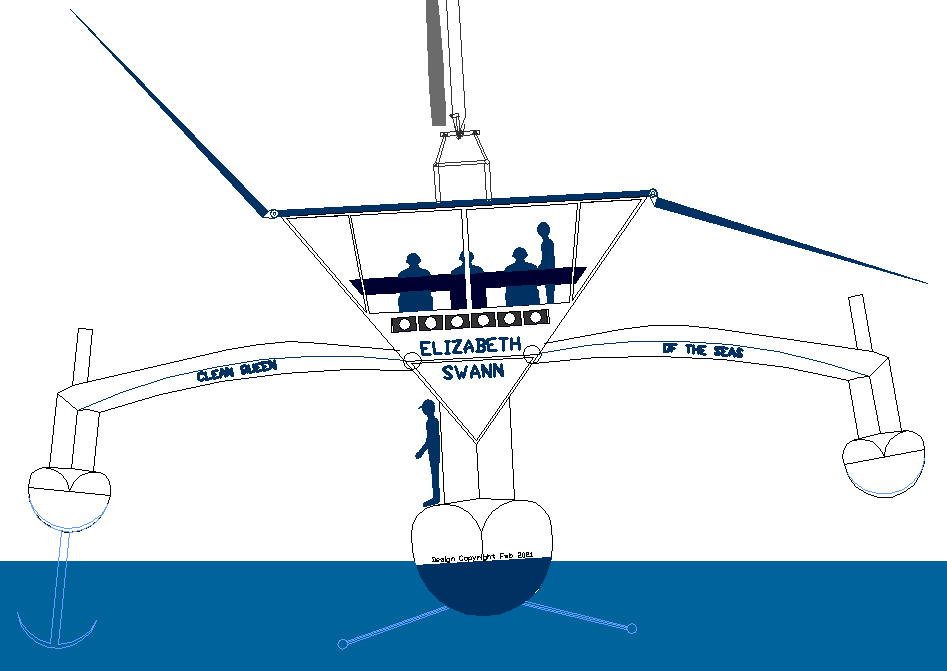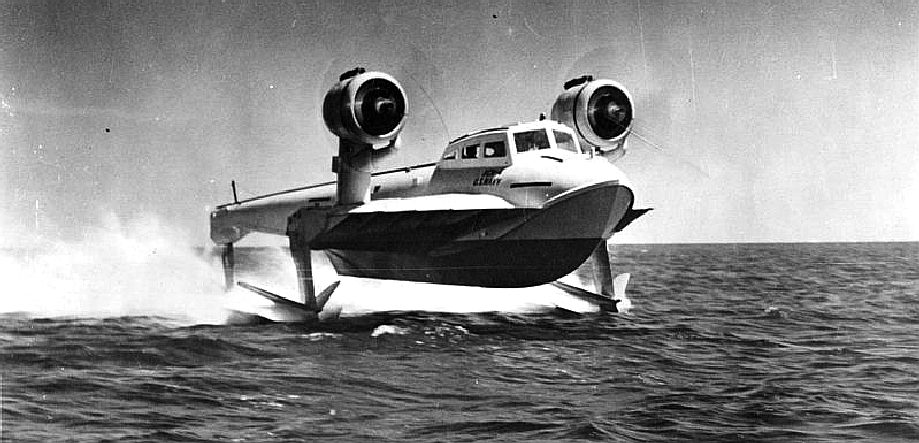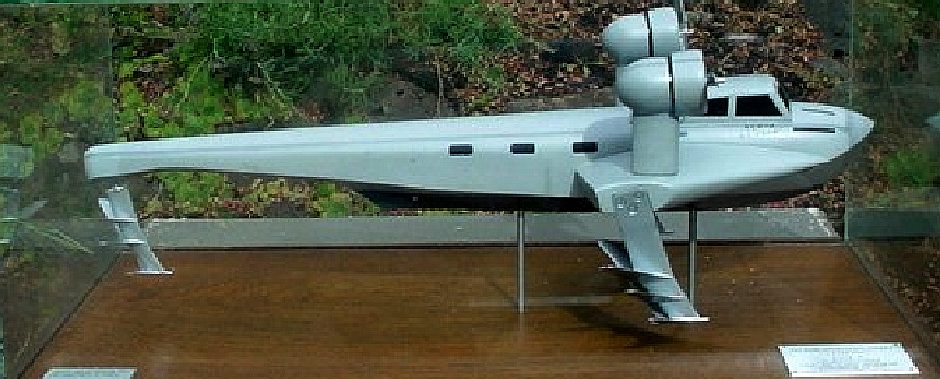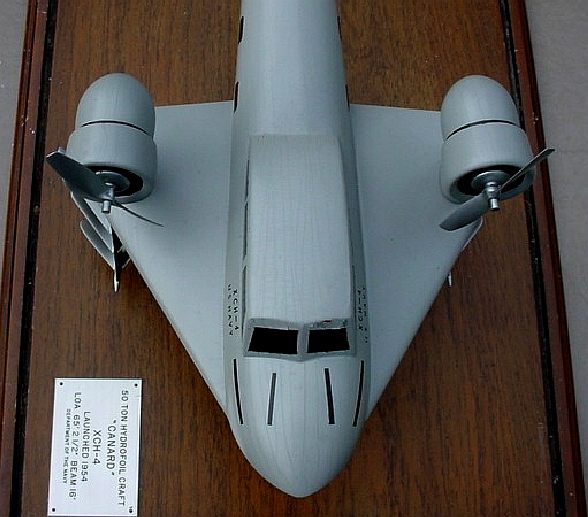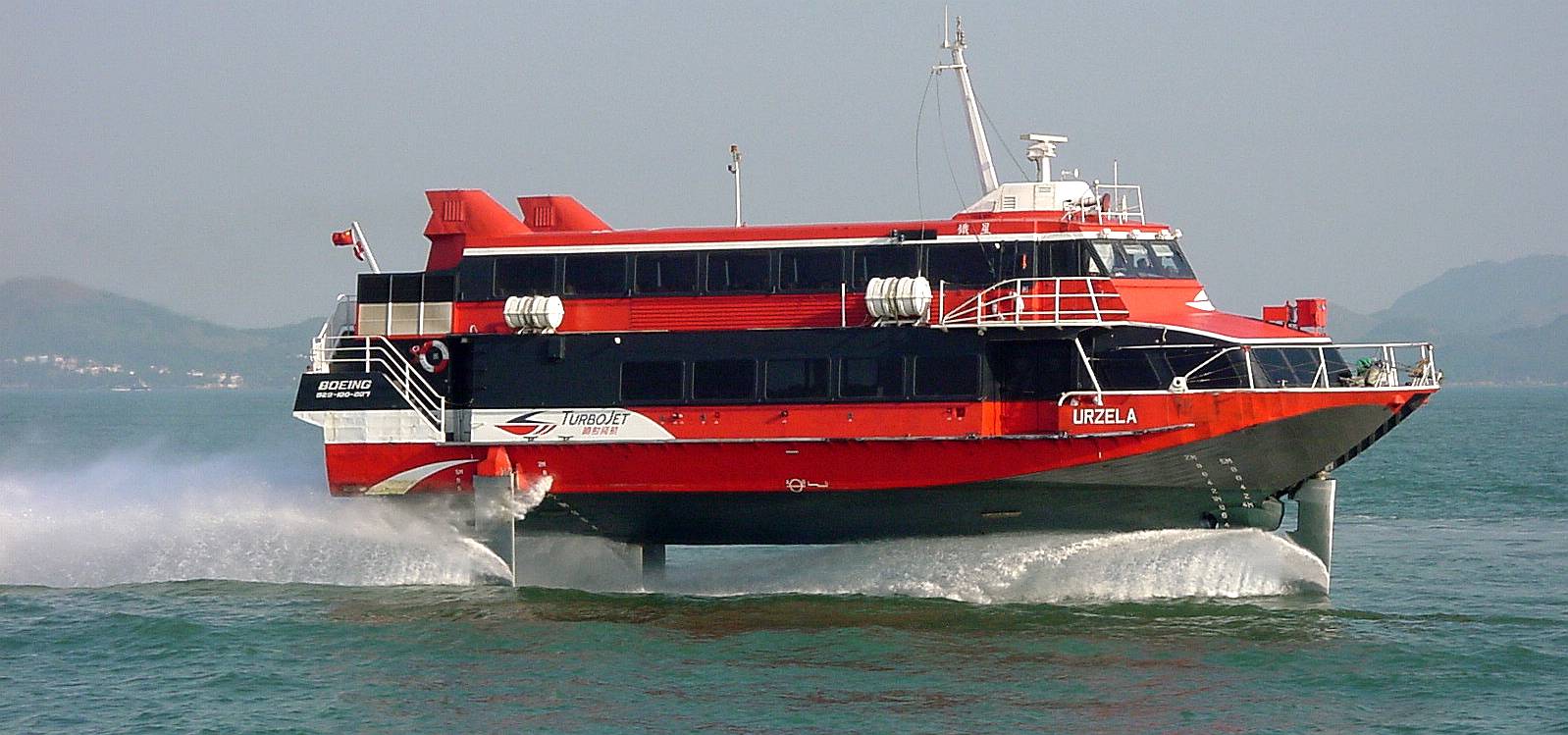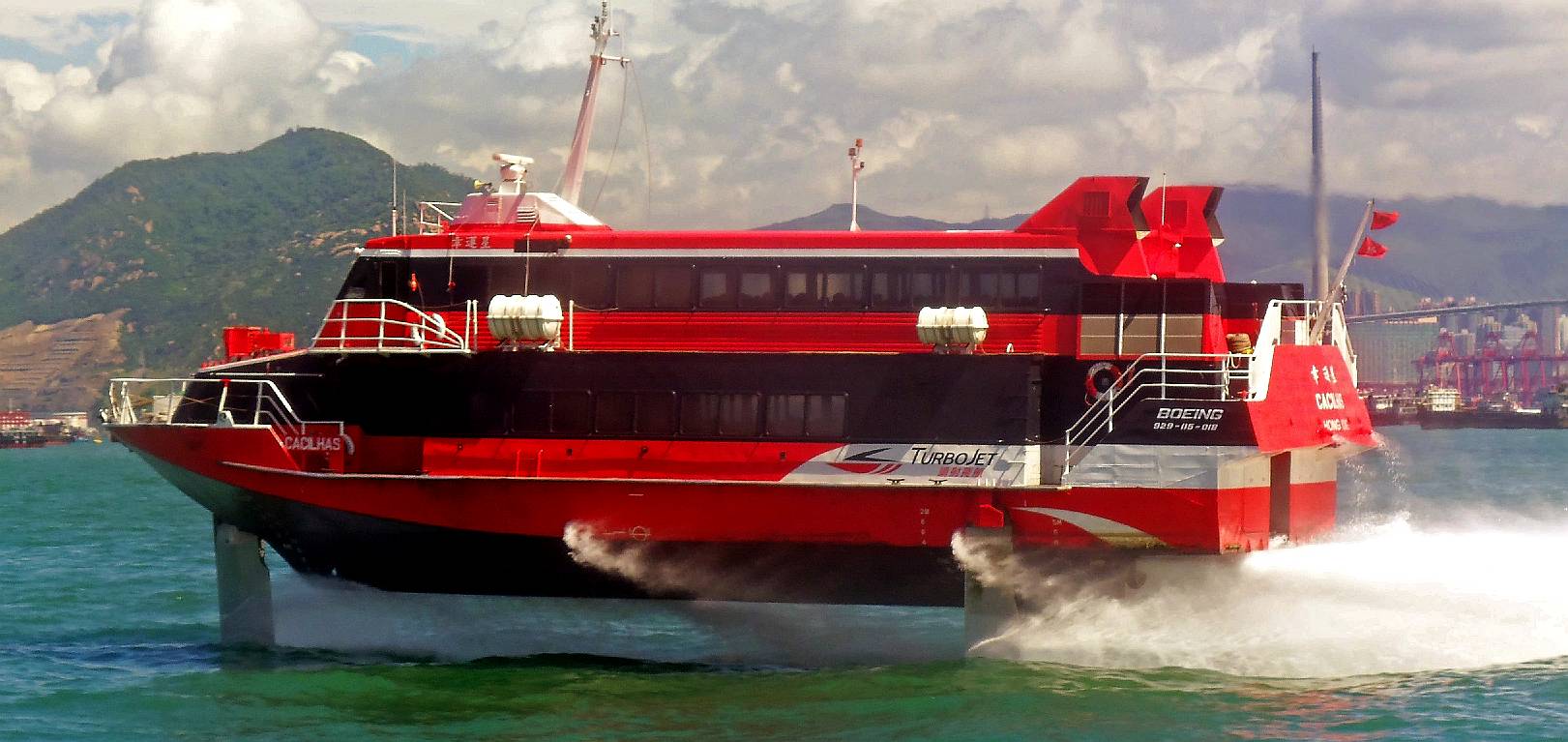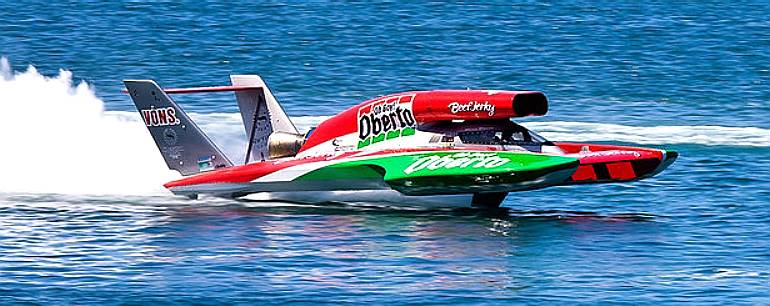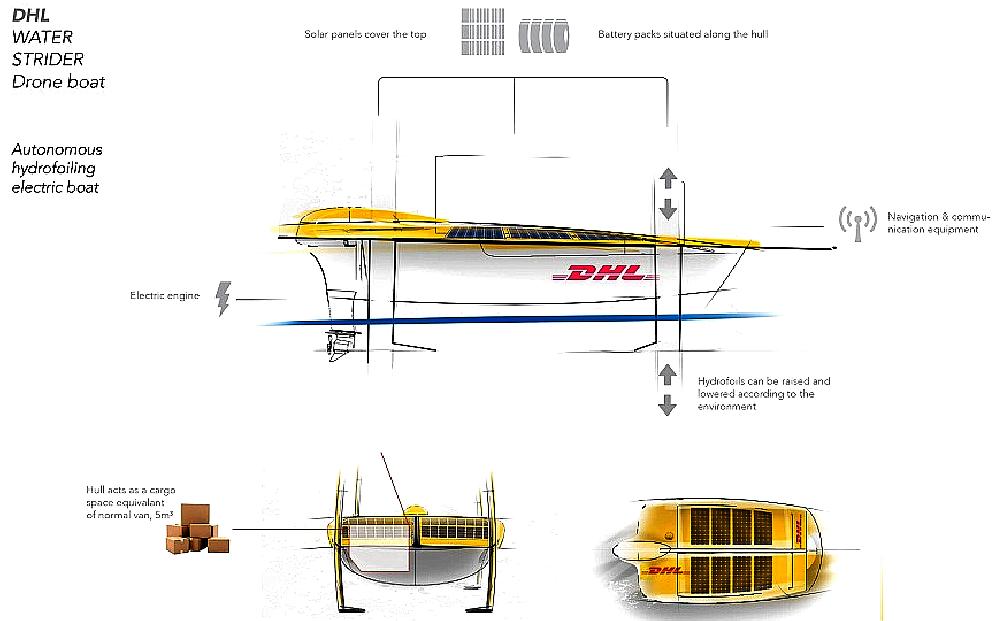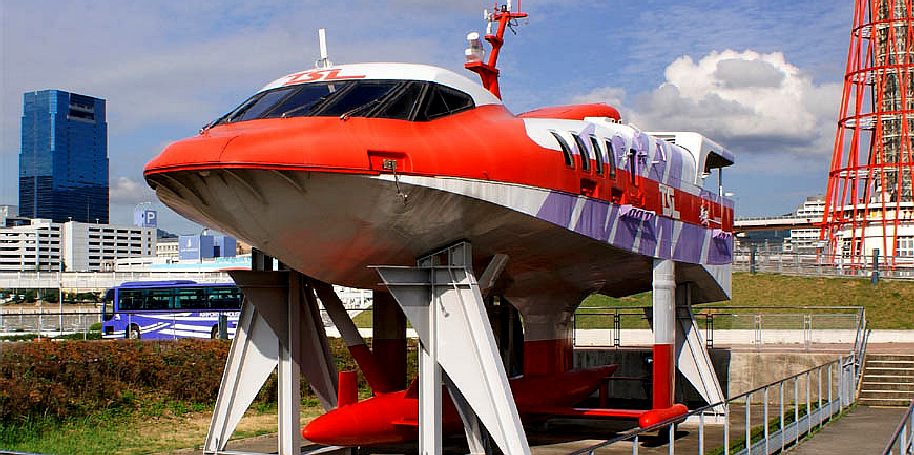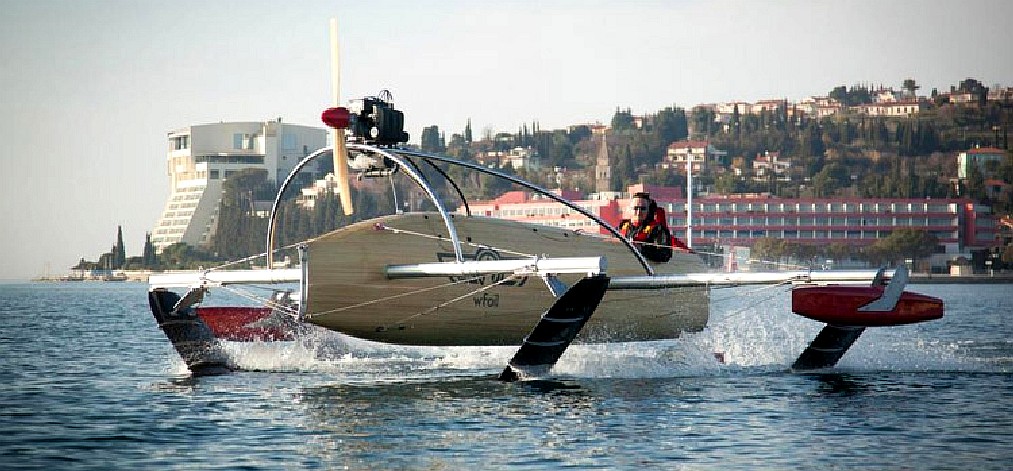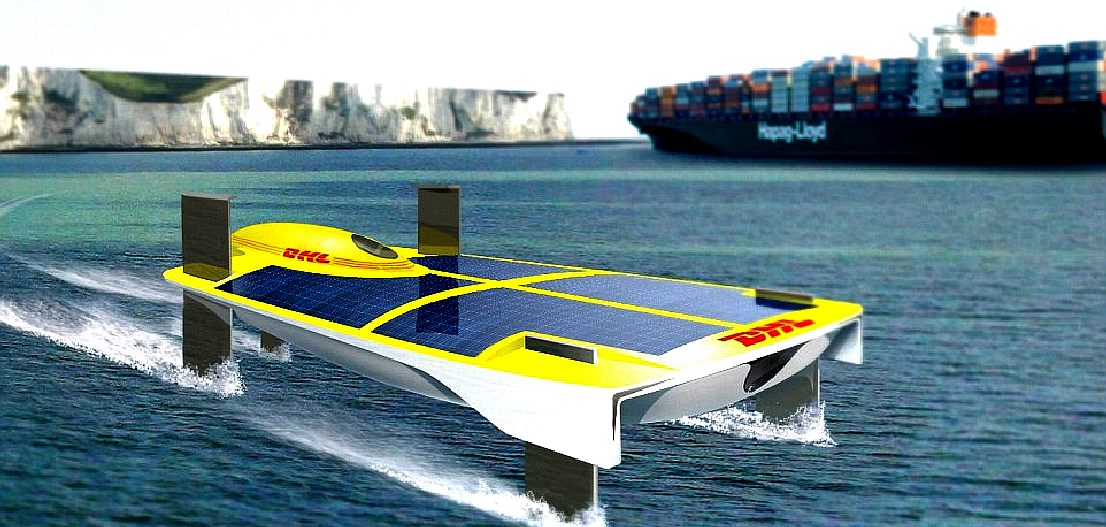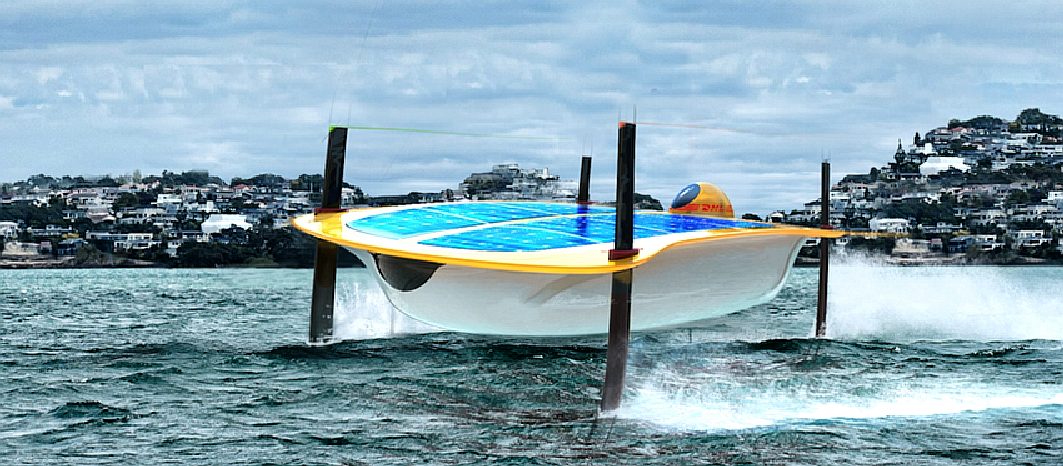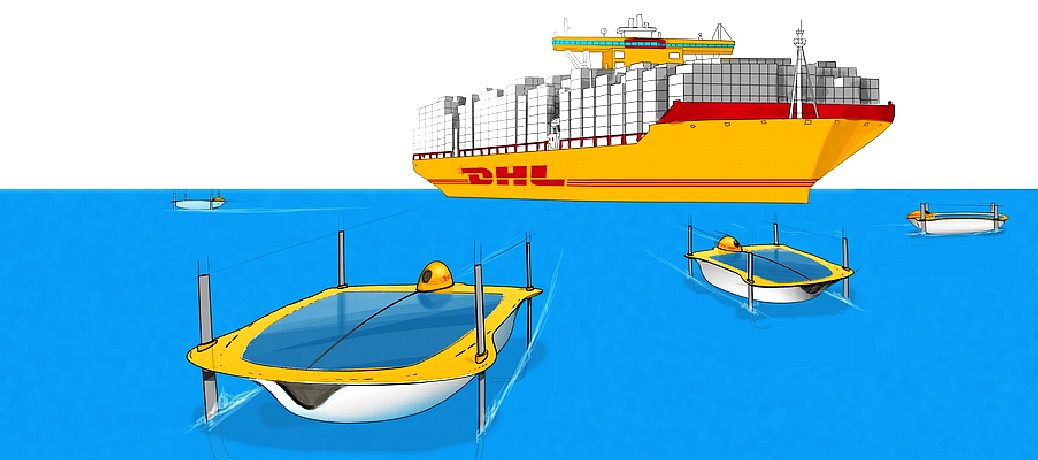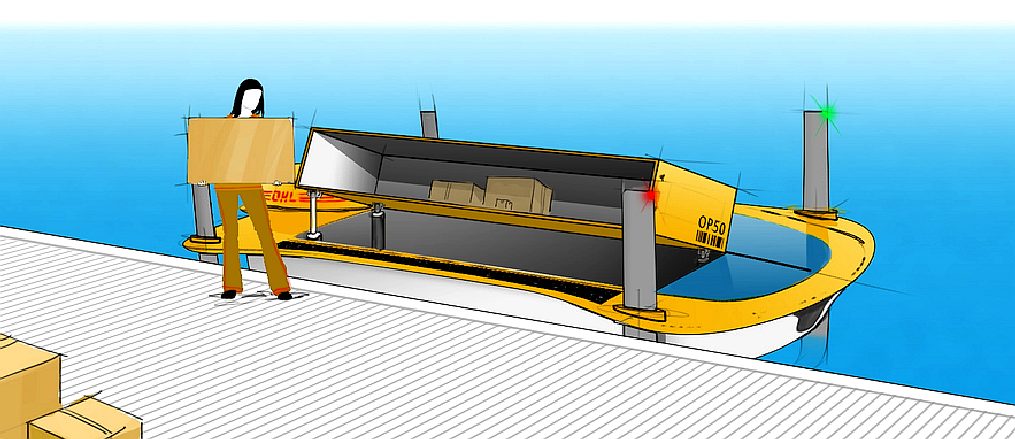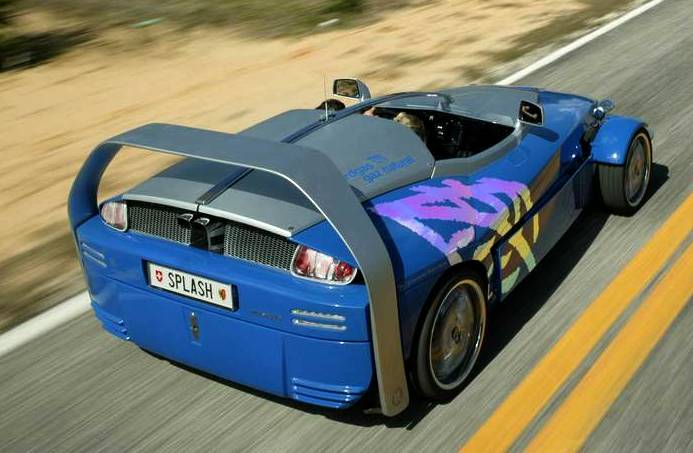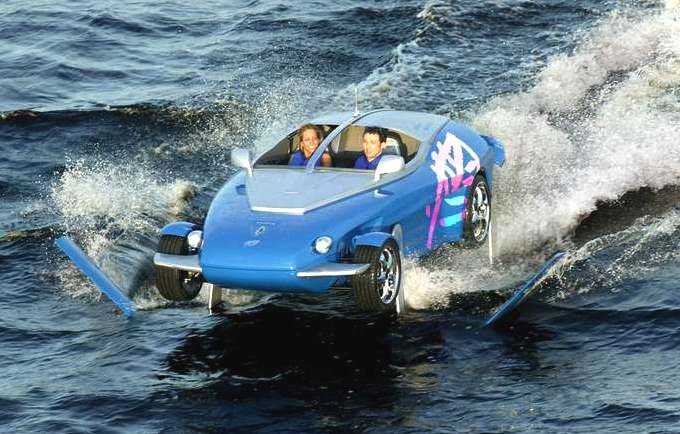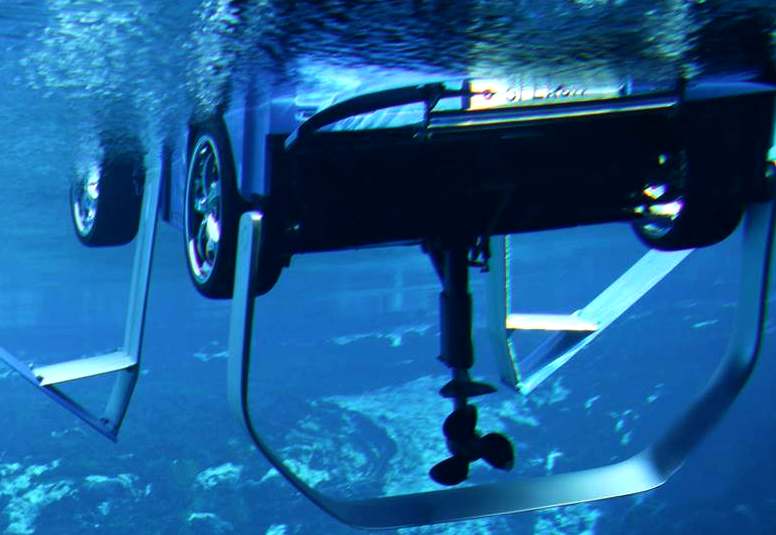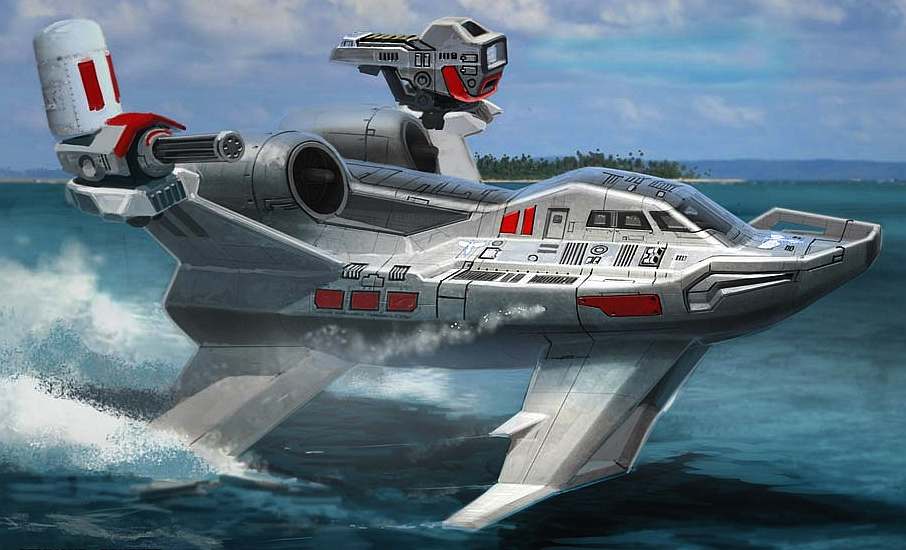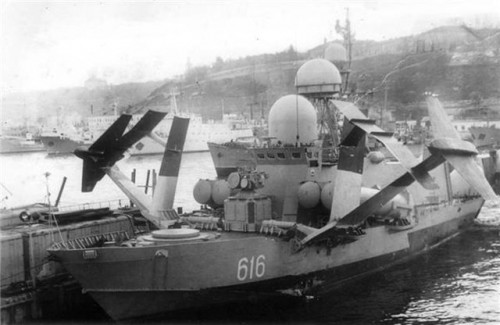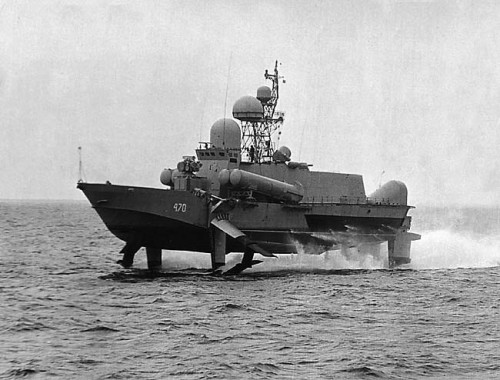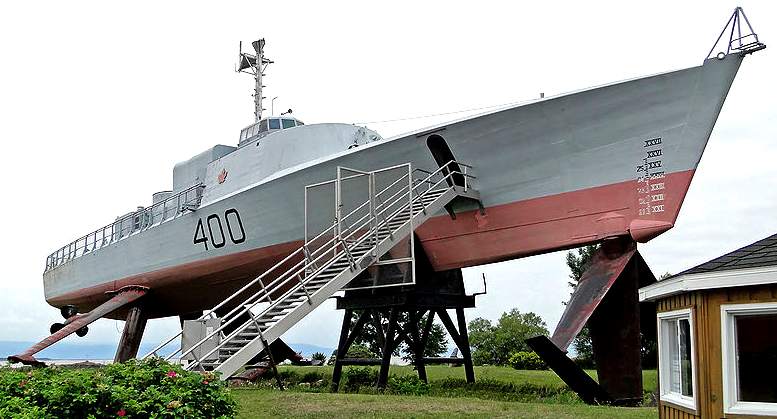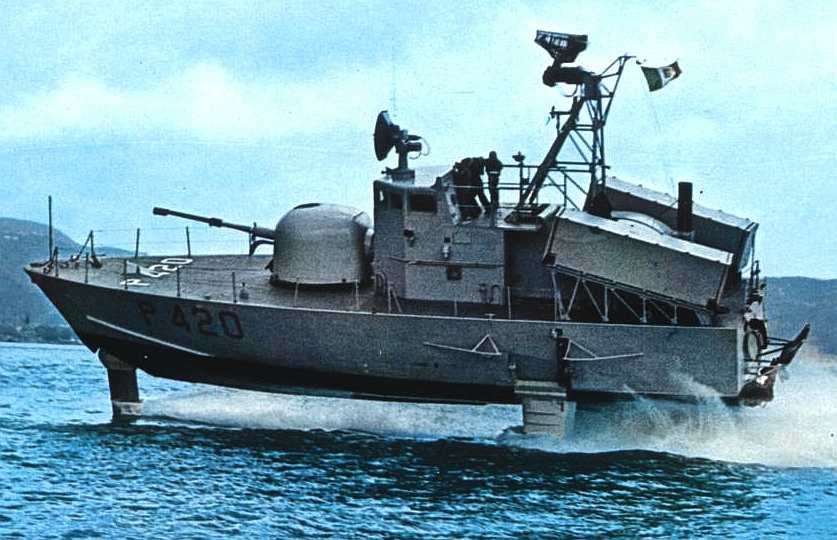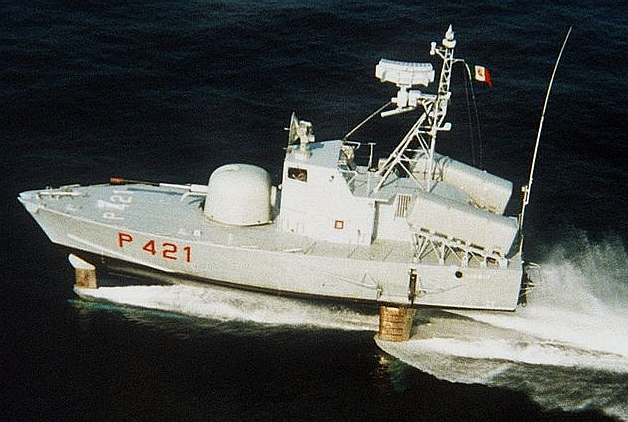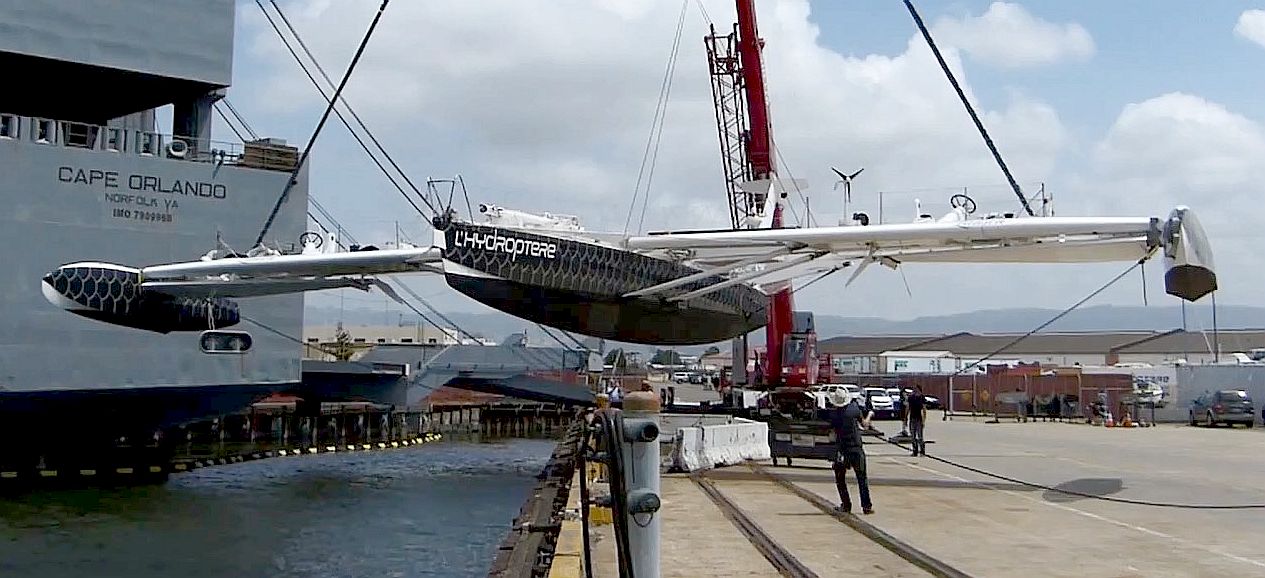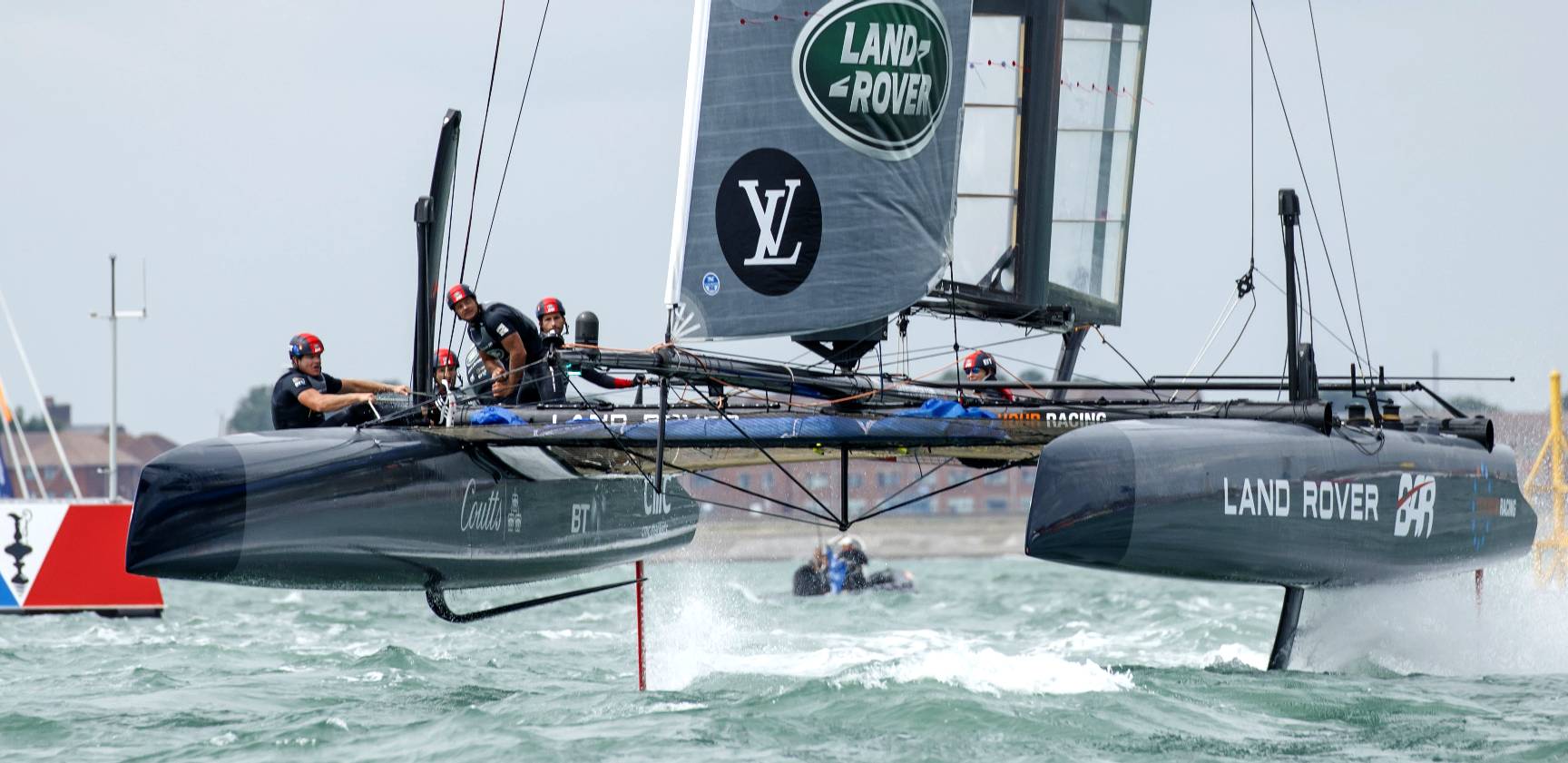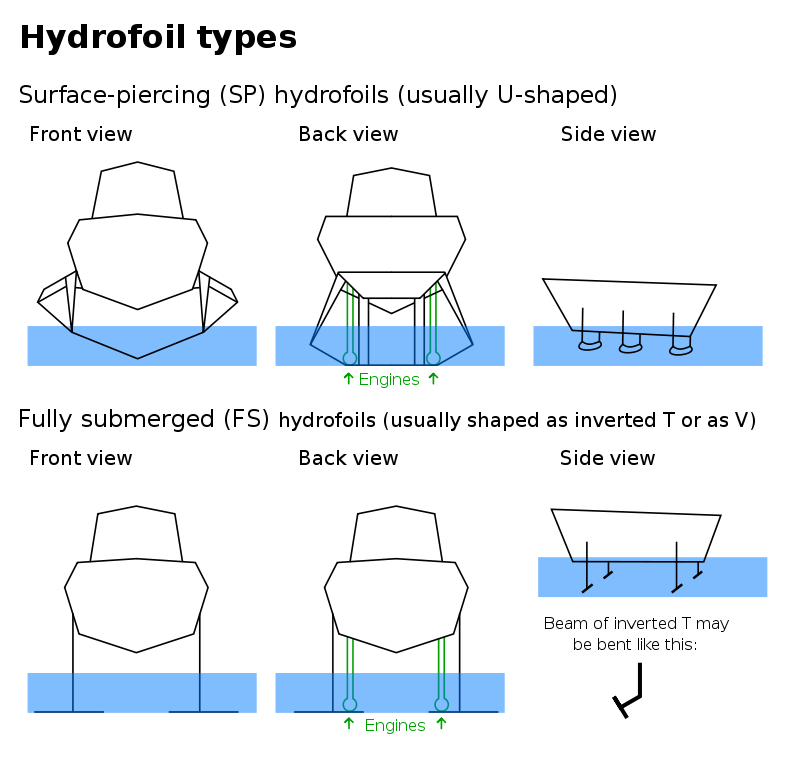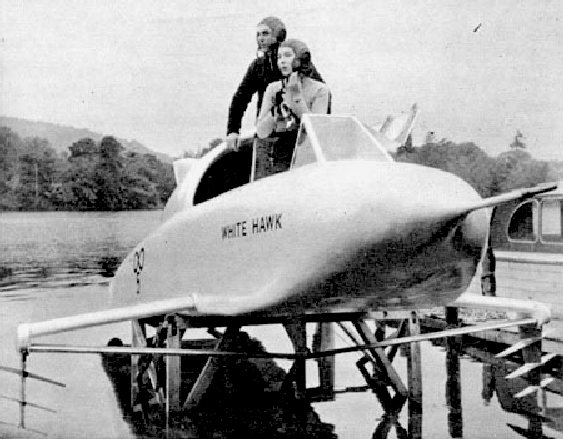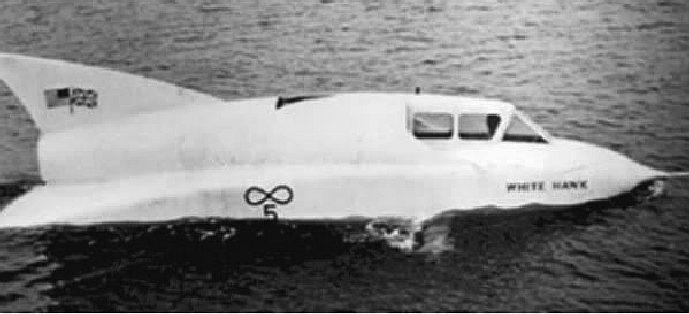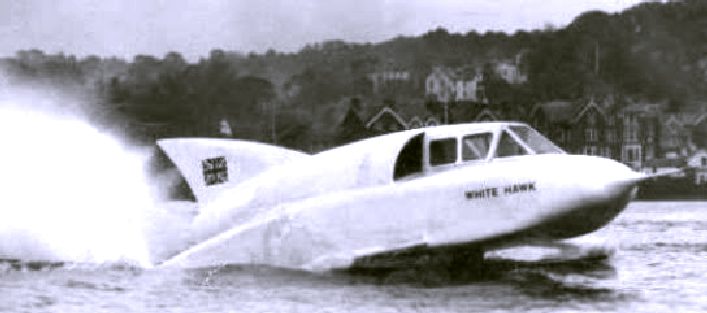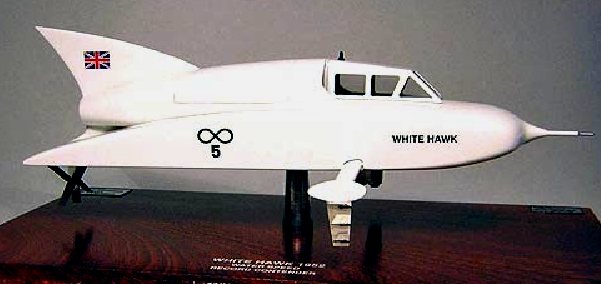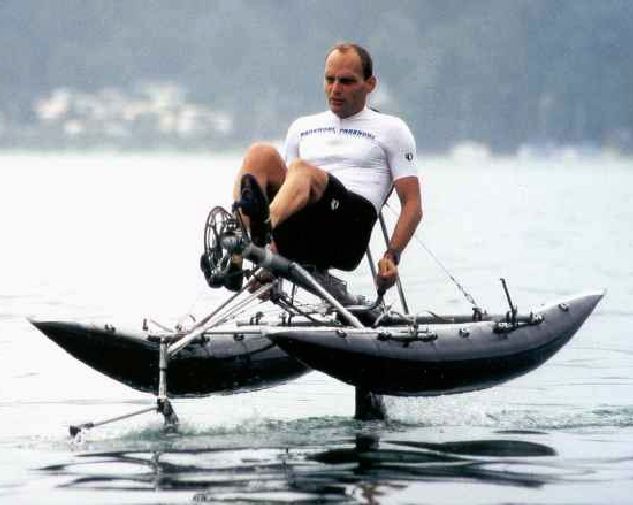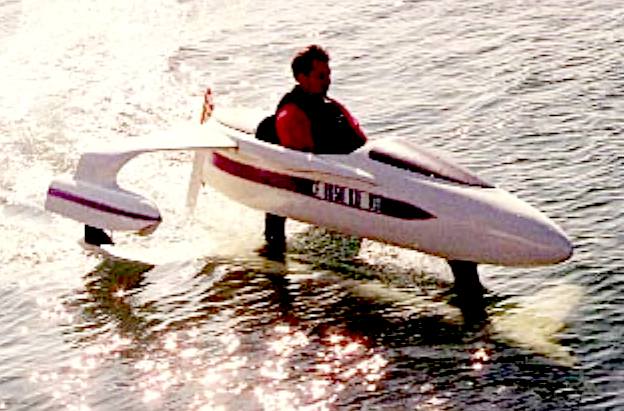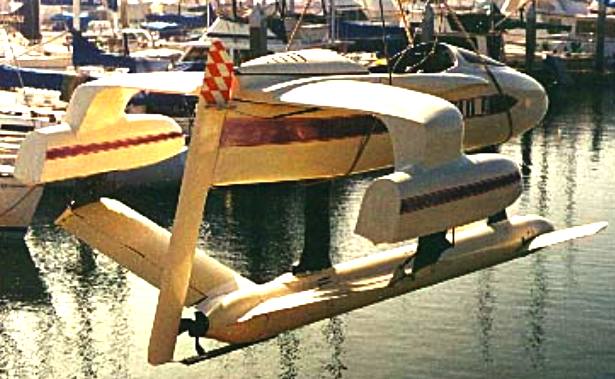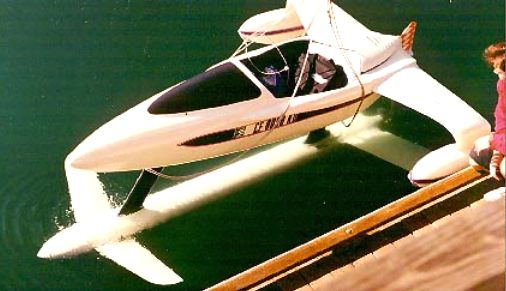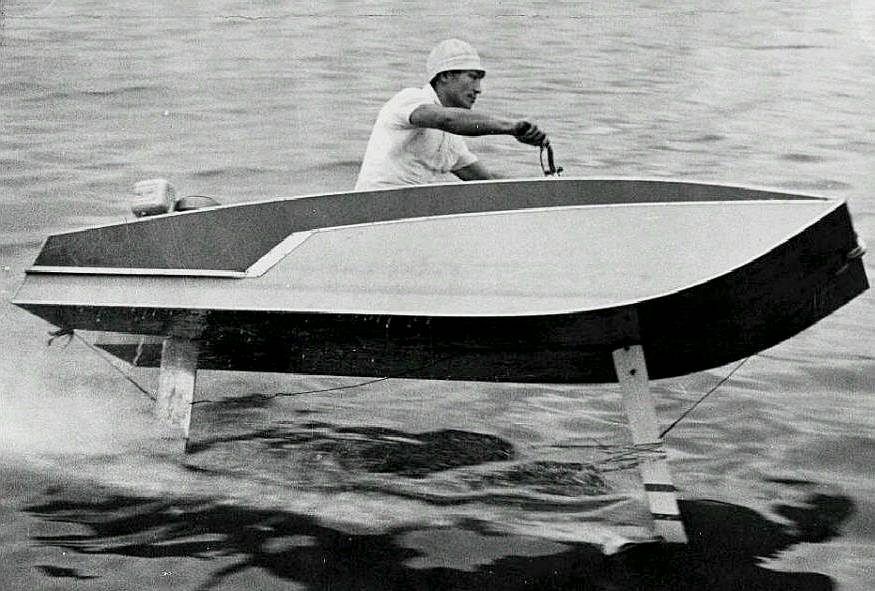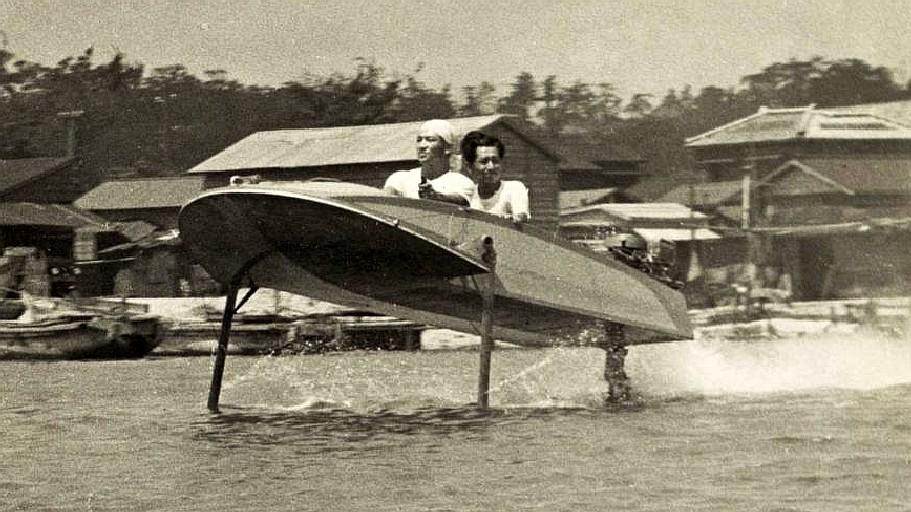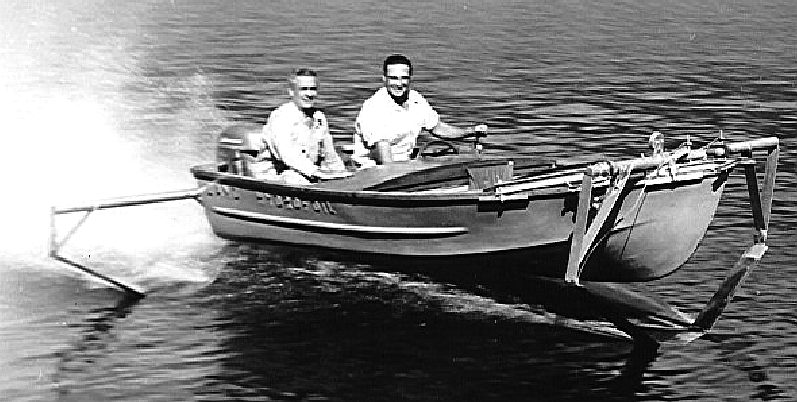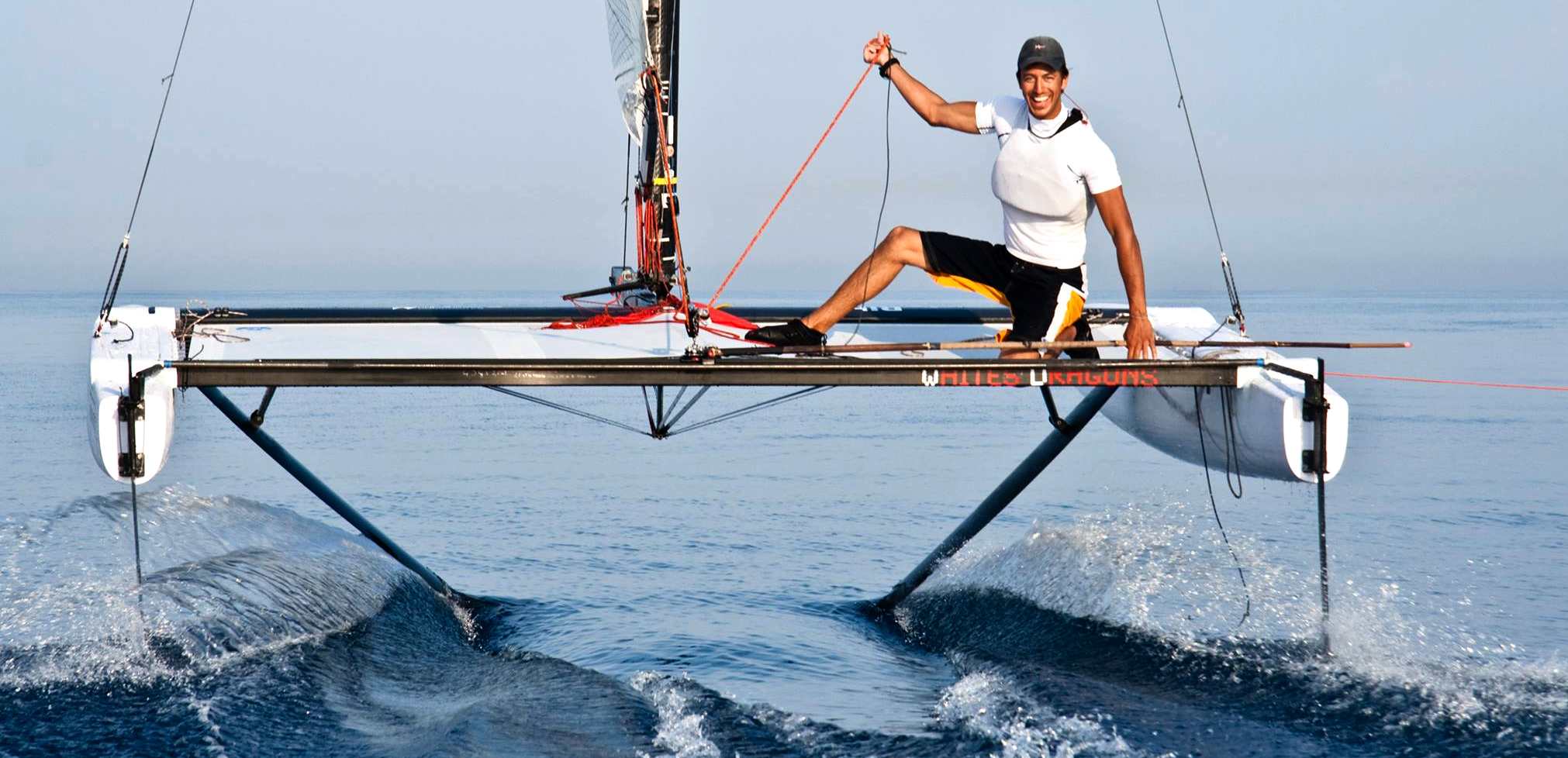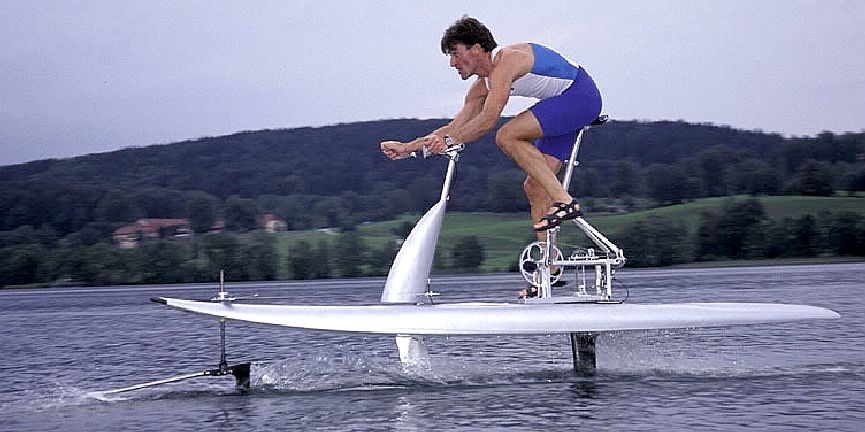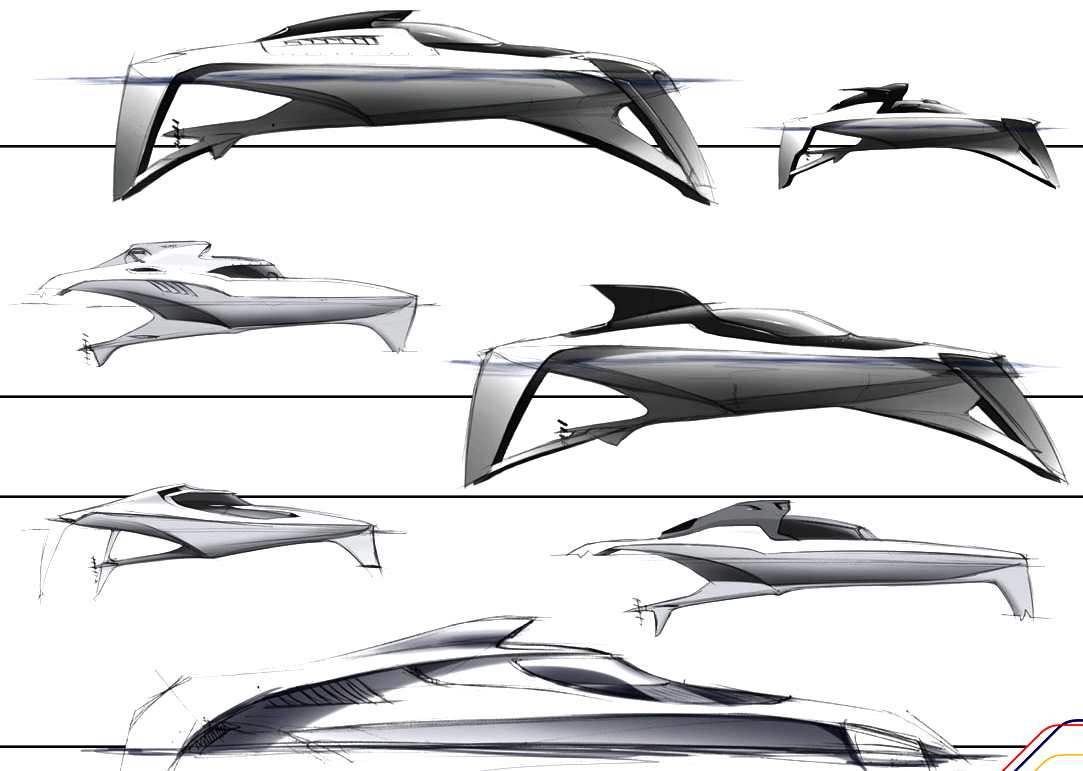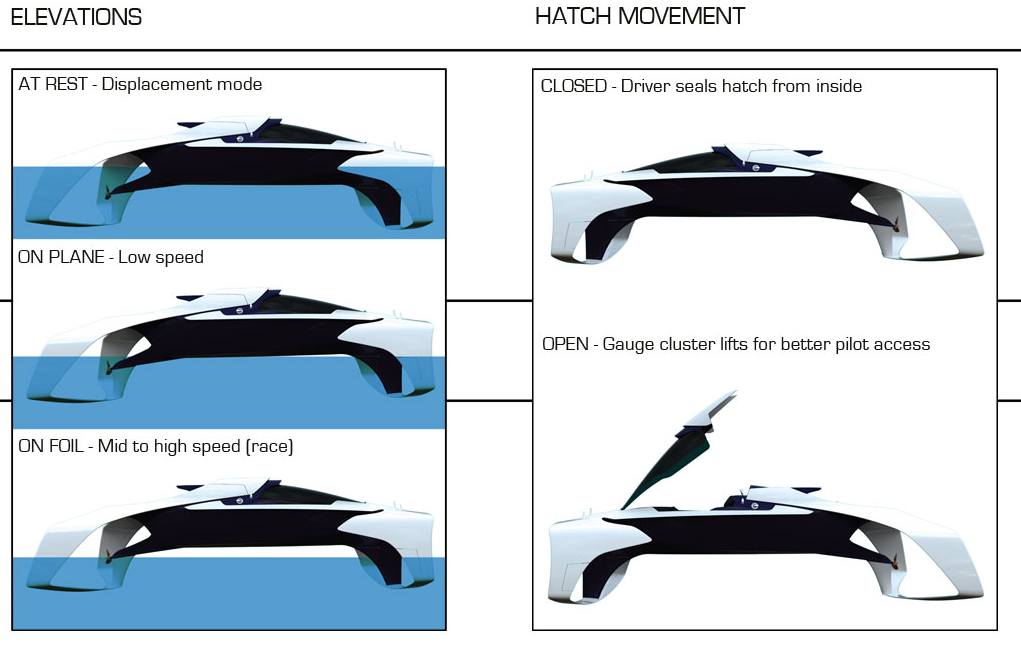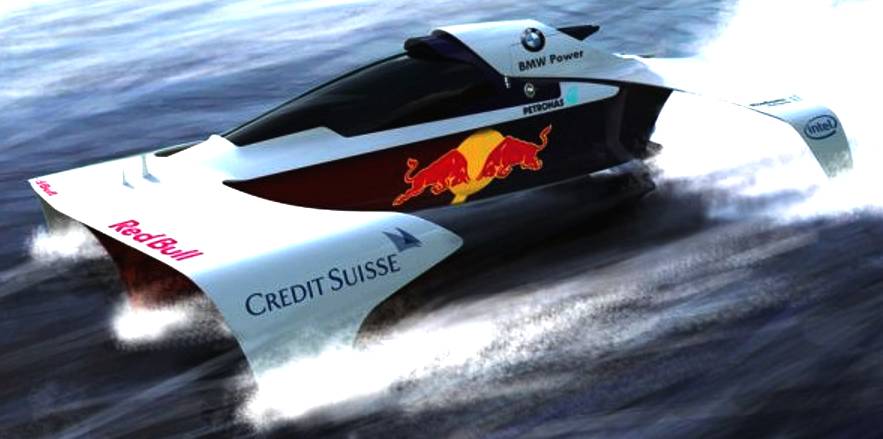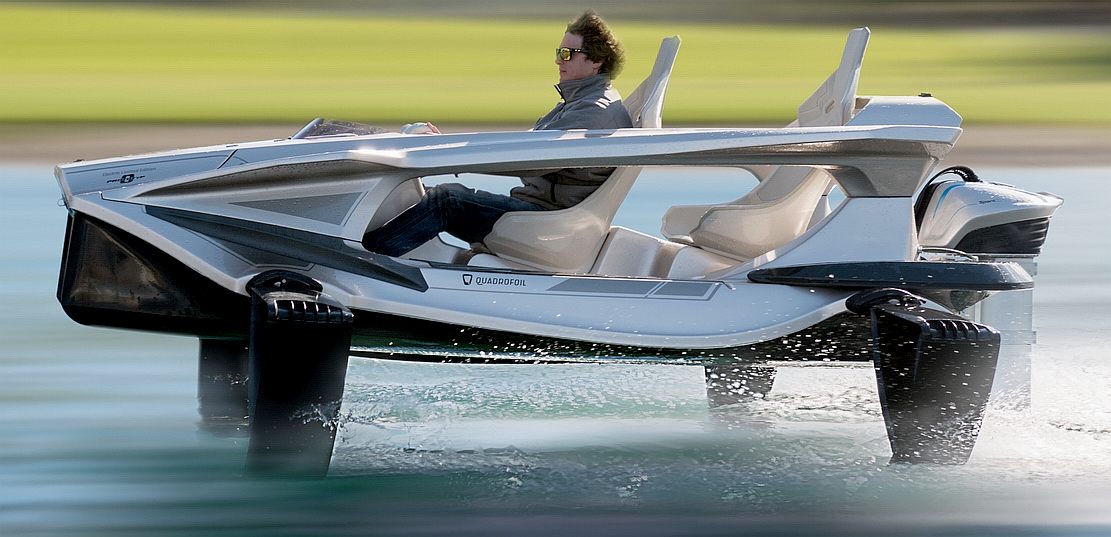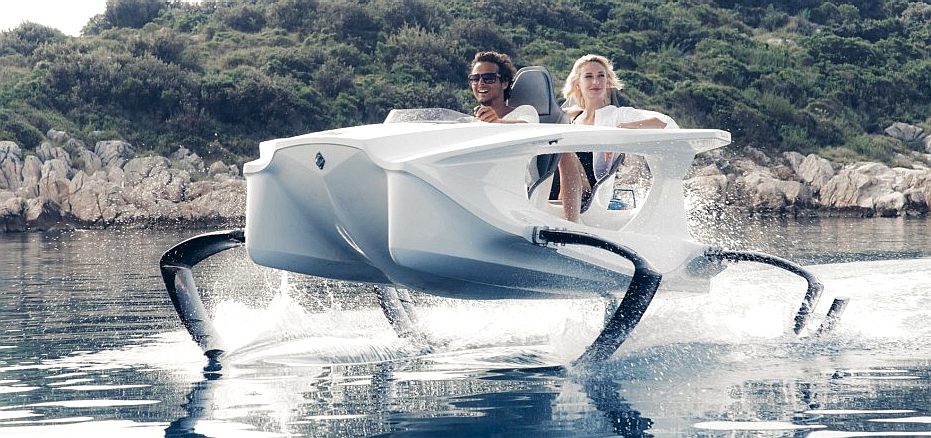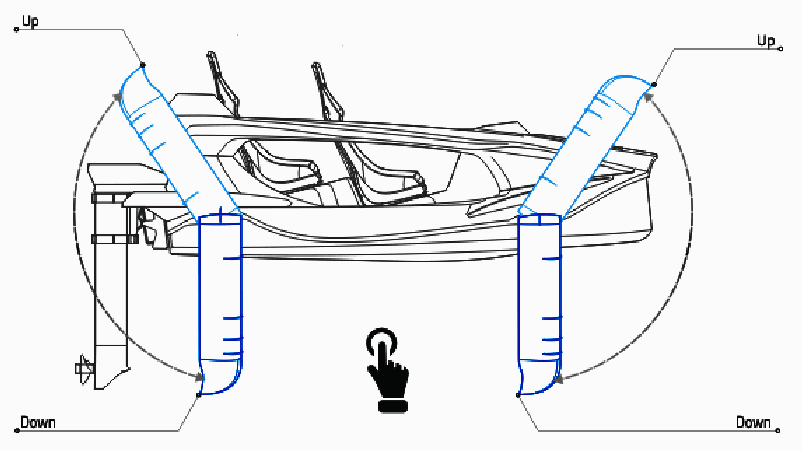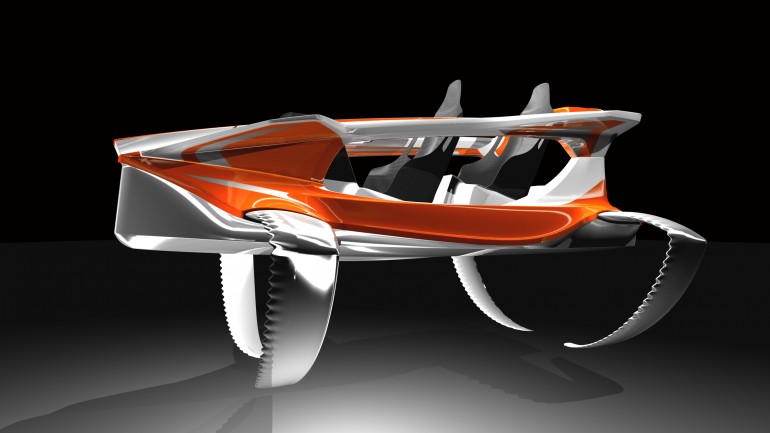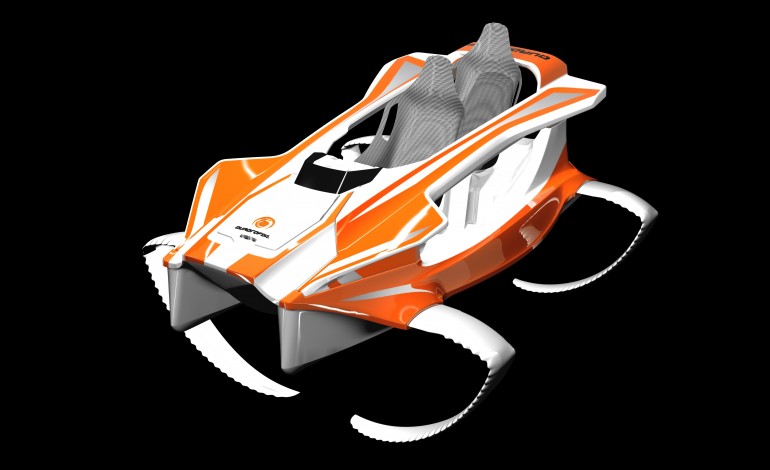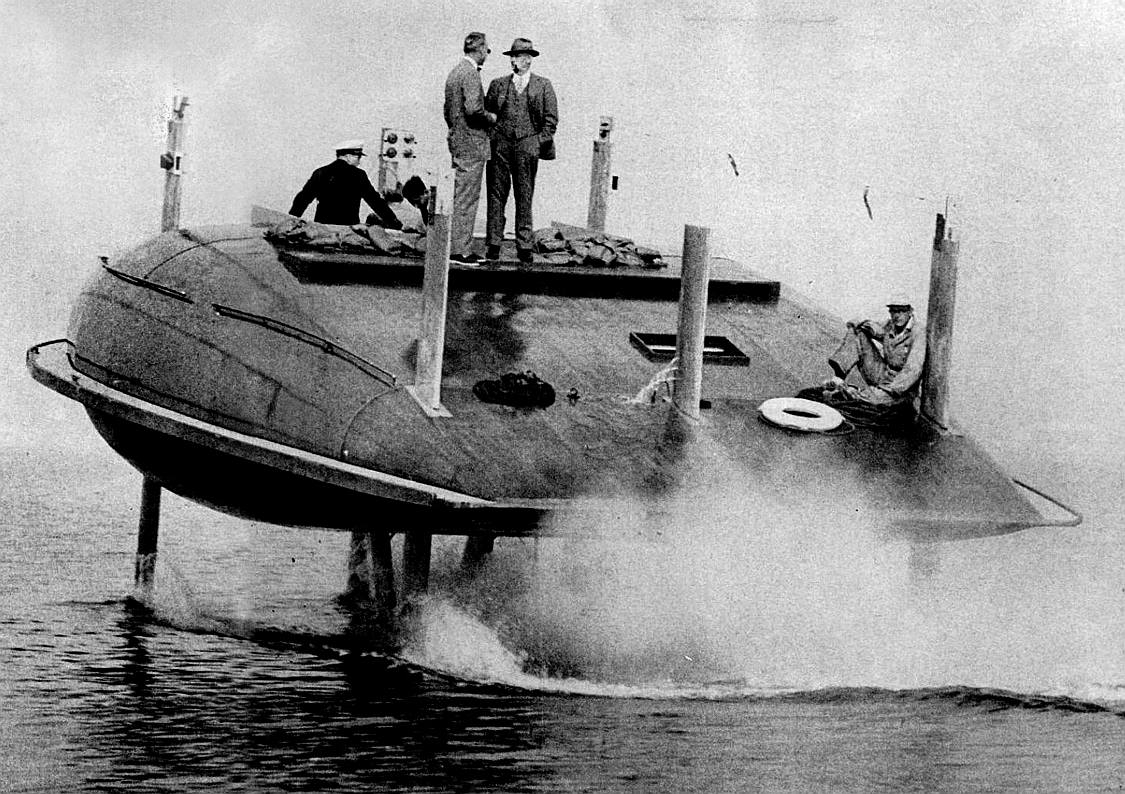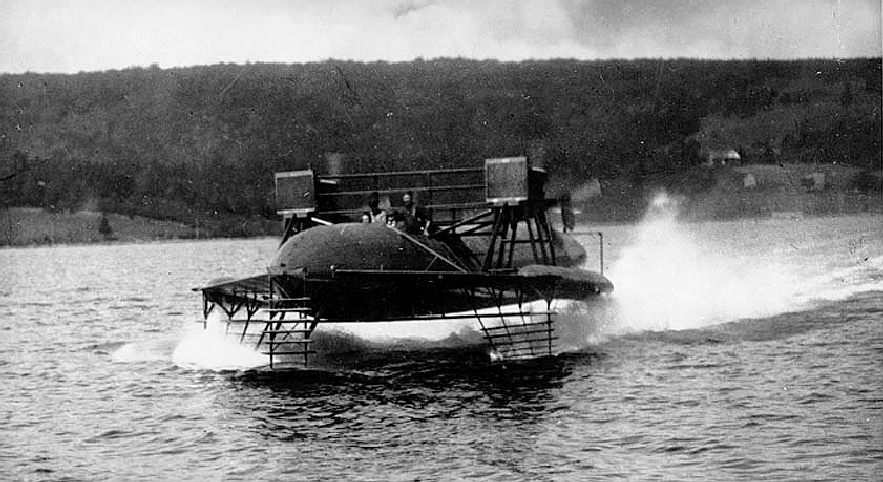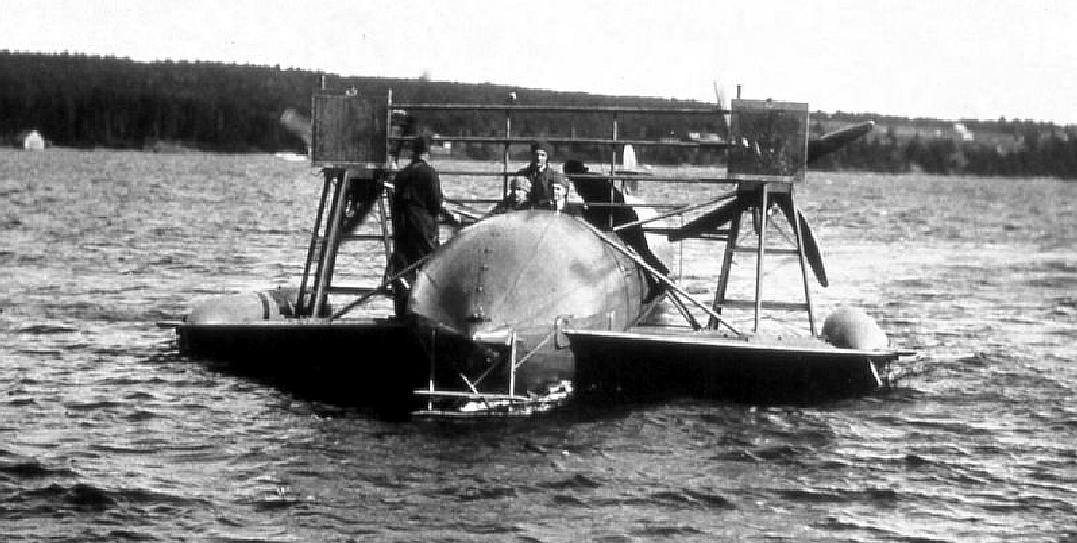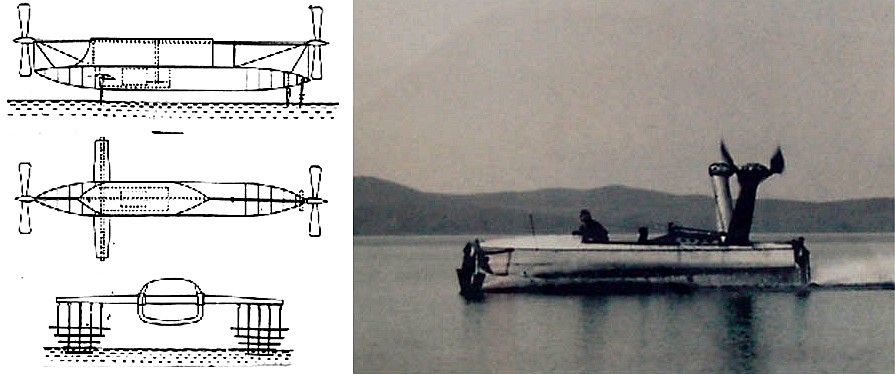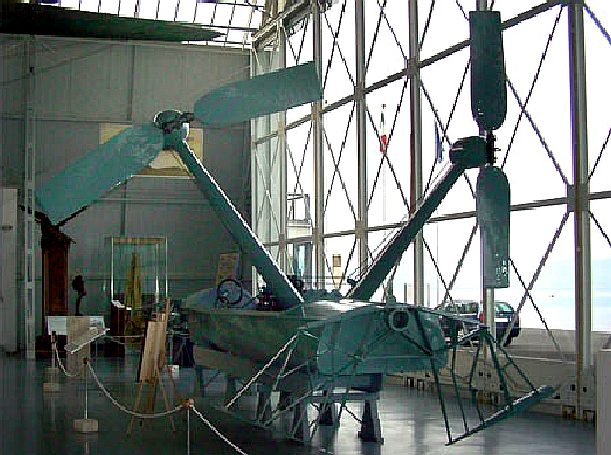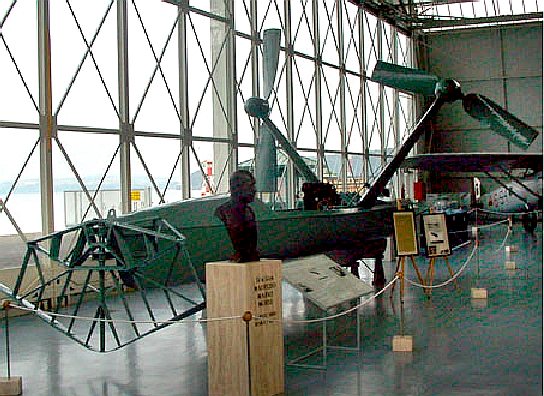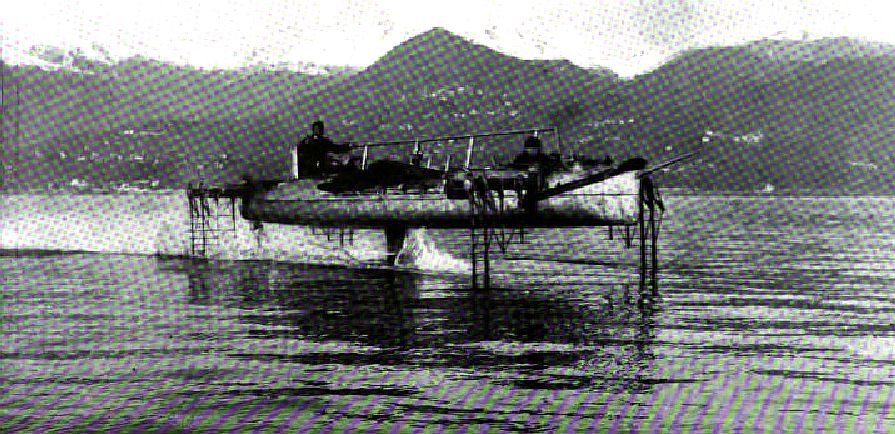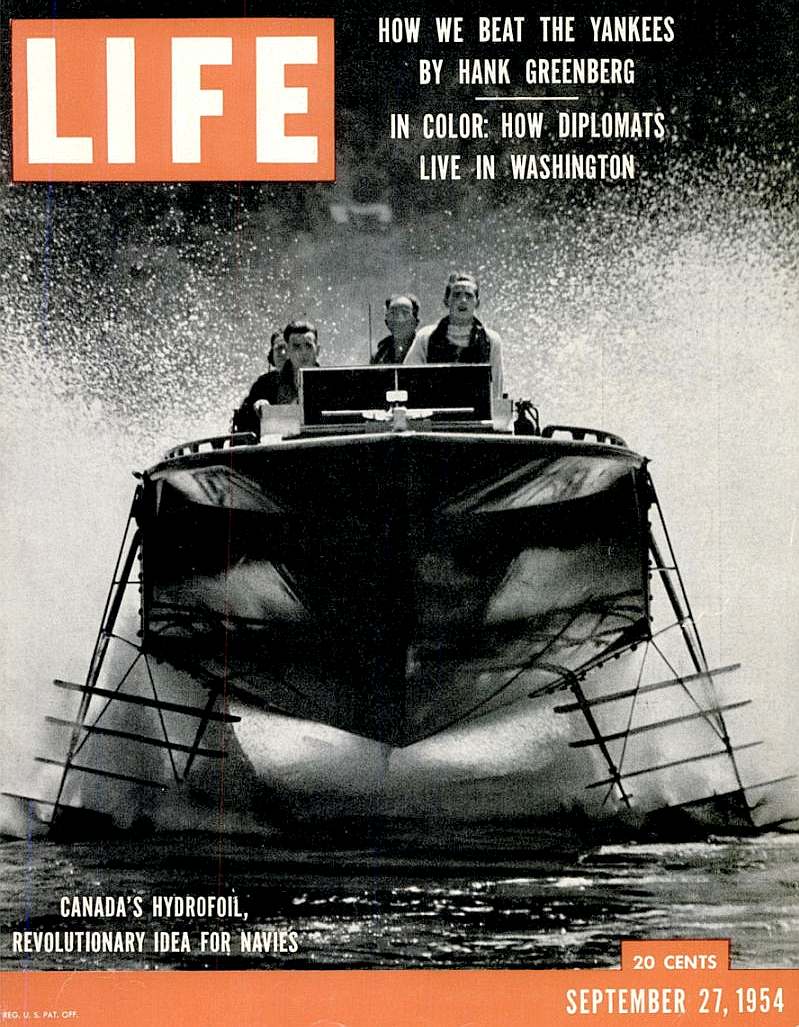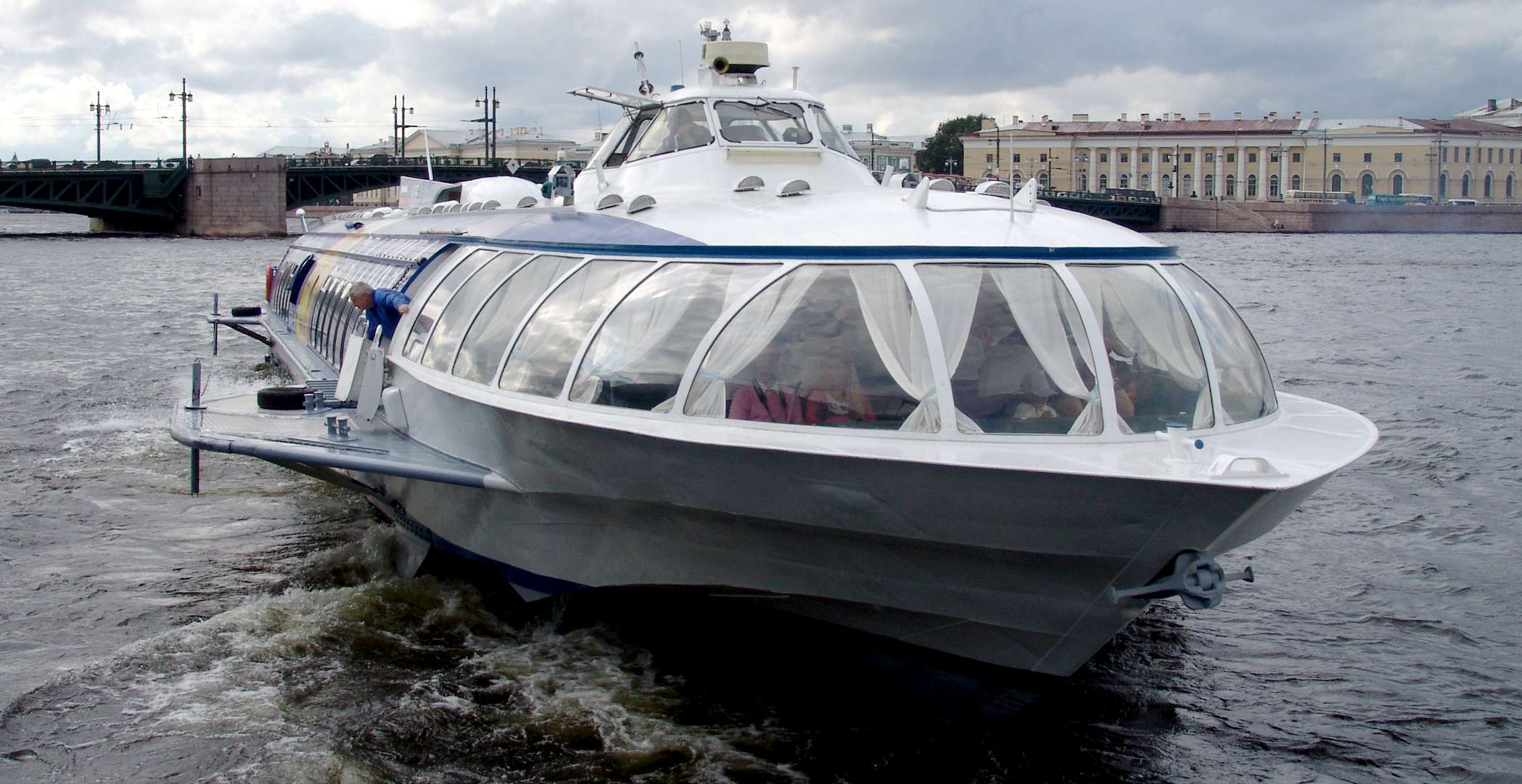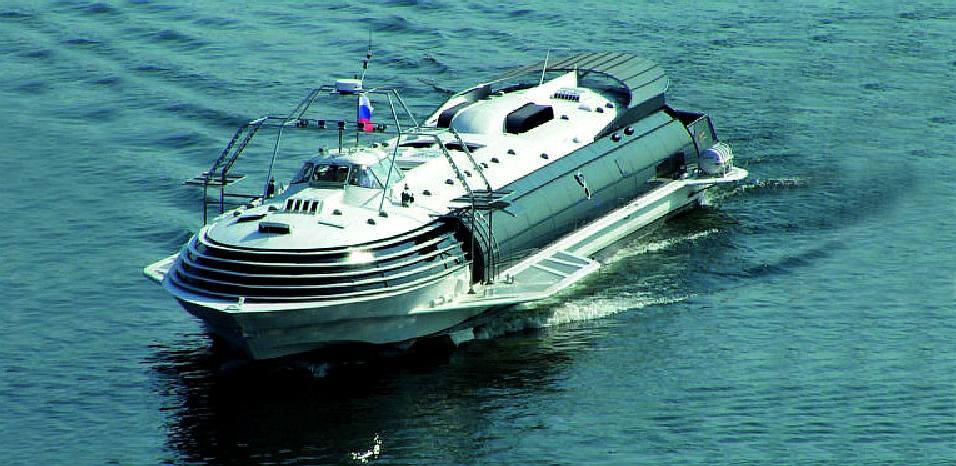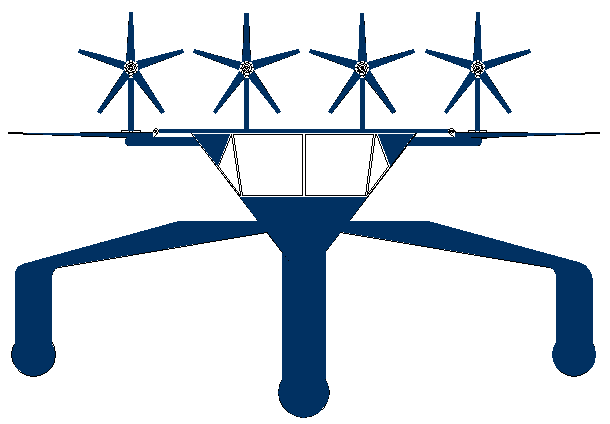|
HYDROFOILS - Renewable Energy Research
PLEASE USE OUR A TO Z INDEX TO NAVIGATE THIS SITE OR SEE HOME
|
|||
|
ELIZABETH SWANN - For their 2021 developments, The Cleaner Ocean Foundation are not attempting to lift their trimaran out of the water, otherwise this solar powered ship would require a higher power to weight density than can reasonably be provided on a continuous basis using only energy from nature - especially in relation to cargo ships - should the design be adapted for commercial purposes. Instead, the development team prefer a compromise where the central hull is stabilized and the outriggers may be trimmed such that the sponson opposing wind forces might deploy a hydrofoil with the arm raised, while the redundant sponson may be lifted completely out of the sea.
Hydrofoil assisted, or hybrid hull tend too achieve hydrodynamic efficiency gains whilst actively improving handling and sea keeping, such as countering sea state and loading conditions. The project is live with academic and specialist subcontractors, looking for commercial and philanthropic backing.
The Flying Dolphin Zeus - passenger vessel currently operating on the Aegean Sea. At lower speeds, the drag of a hydrofoil climbs while the drag of a displacement hull drops as the speed goes down. So there's some crossover speed below which it doesn't make sense to try to fly - you can go faster for the same power without the foils. But at the higher speeds, it's possible to reduce the drag compared to a planing hull and cruise more efficiently because of the greater span of the hydrofoils compared to the width of the hull. Depending on the takeoff speed, you could optimize the hull for low speeds - say by going to a long, narrow displacement hull - while using hydrofoils to be efficient at high speeds. The hydrofoils can be retracted completely out of the water, allowing the hull to change gears and be more efficient than a conventional planing hull across the whole speed range.
US NAVY CARL XCH-4 - Seen here with hydrofoils clearly lifting the hull out of the water, this is another air propeller driven prototype after A G Bell. The Carl XCH-4 "Canard" hydrofoil was a U.S. Navy test boat in the 50s. This 16,500 lb, 53 foot craft was known officially as "Experimental Craft Hydrofoil No. 4." Unofficially it was called "The Carl Boat" after its principal designer, William P. Carl. It had a seaplane type hull supported by two sets of foils forward, and a single strut and foil aft. Two 250 hp Pratt and Whitney R-985 aircraft engines with two-bladed controllable pitch propellers 8 ft in diameter provided the trust to carry this craft to the highest speed attained since those achieved by Alexander Graham Bell’s HD-4. During trials of the CARL XCH-4 in 1953, the crafts design speed of 65 mph was exceeded in three to four foot waves. During US Navy tests off Long Island NY, someone called the US Coast Guard to report that "A seaplane had been trying unsuccessfully to take off and undoubtedly needed help" an understandable error in view of the craft’s appearance!
MODEL OF THE CARL XCH-4 - Against the advantages of hydrofoils are the difficulty of engineering a hydrofoil system compared to designing a planing hull. It's not enough to draw some lines that look pretty much like other boats and have a reasonable expectation that it will perform the same way. You have to design the hydrofoil section and planform specifically for the mission requirements, and deal with the stability and dynamics of the boat in a seaway. And in waves, the currents due to the orbital motion of the water can affect the hydrofoil as much as the difference in height of the water surface. A fully submerged hydrofoil needs to have a feedback control system of some sort, and this means an electronic system with sensors, computers and actuators, or at least a mechanical feedback system. This kind of control system engineering is not something that most designers are used to doing. It takes mathematical models and test data to get it right.
BOEING
929 - The Boeing 929 Jetfoil is the name for a passenger-carrying waterjet-propelled hydrofoil design by Boeing.
Boeing began adapting many systems used in jet airplanes for hydrofoils. Robert Bateman led development. Boeing launched its first passenger-carrying
waterjet-propelled hydrofoil in April 1974. It could carry from 167 to 400 passengers. It was based on the same technology pioneered by the patrol hydrofoil Tucumcari, and used some of the same technology used in the Pegasus class military patrol hydrofoils. Currently this product line is sold to the Japanese company Kawasaki Heavy Industries.
AQUAJET - In 1959, Boeing began their research and development of hydrofoils. The hydrodynamic test system (HTS), called the Boeing "Aqua-Jet," was launched in 1961. It was a dual-cockpit jet-powered hydroplane that served as an aquatic version of a wind tunnel. Powered by an Allison J-33 jet engine, the HTS was designed to provide a level and stable platform for straightaway runs of up to 132 knots (115 mph/185 kph). A controllable fixture mounted between two prows held models of hydrofoils in the water during the test runs. You may be forgiven for thinking that the AquaJet looks a little like the K7 Bluebird, because it does. It uses the same general configuration and same mounting location for its jet engine.
In 1979, the Royal Navy purchased a Boeing Jetfoil, HMS Speedy, to provide the Royal Navy with an opportunity to gain practical experience in the operation and support of a modern hydrofoil, to establish technical and performance characteristics, and to assess the capability of a hydrofoil in the
Fishery Protection Squadron.
In 1980 B&I shipping lines opened a Jetfoil service from Dublin to Liverpool with the jetfoil Cú Na Mara (Hound of the Sea). The service was not a success and was discontinued at the end of the 1981 season.
SPECIFICATIONS - Tonnage: 30 metric tons - Depth: 3.0 m - Decks: 2 - Propulsion: 2x Rolls-Royce Allison 501KF Gas Turbine engines - Speed: 43-47 knots (80 km/h) - Capacity: 240 passengers (160-400) - Complement: 3 officers (captain, chief engineer, engineer). The Boeing 929 is widely used in Asia for passenger services between the many islands of Japan, between Hong Kong and Macau and on the Korean peninsula.
The term "hydrofoil" can have
two meanings: 2. The term "hydrofoil" is often used to refer to boats using hydrofoil technology.
Hydrofoils can be artificial, such as the rudder or keel on a boat, the diving planes on a submarine, a surfboard fin, or occur naturally, as with fish fins, the flippers of aquatic mammals, the wings of swimming seabirds, or other creatures like the sand dollar.
The term "hydrofoil" is commonly used for the wing-like structure mounted on struts below the hull, or across the keels of a catamaran in a variety of boats (see illustration), which lifts the boat out of the water during forward motion, in order to reduce hull drag.
As a hydrofoil-equipped watercraft increases in speed, the hydrofoil elements below the hull(s) develop enough lift to raise the hull up and out of the water. This results in a great reduction in hull drag, and a further corresponding increase in speed and efficiency in operation in terms of fuel consumption
A wider adoption of the technical innovations of hydrofoils is prevented by the increased complexity of building and maintaining them. Hydrofoils are generally prohibitively more expensive than conventional watercraft. However, the design is simple enough that there are many human-powered hydrofoil designs. Amateur experimentation and development of the concept is popular. A boat equipped with hydrofoils is also called a hydroplane (boat).
What a beauty: Miss Madison flying at Mission Bay, San Diego 2007
DHL HYDROPLANE "WATER STRIDER" WINS FORMULA E INSPIRED INNOVATION CONTEST
It’s an autonomous hydrofoil electric-powered watercraft capable of carrying up to five cubic meters of cargo – and it could be part of the future of urban and coastal logistics. The “Water Strider” is the brainchild of two transport design students in London – and it’s the winner of the inaugural, Formula E-inspired DHL Blue Sky Transport Design Award.
A
MORE SUSTAINABLE FUTURE
Oliver and Philippe’s Water Strider is an autonomous hydrofoil electric boat capable of carrying up to five cubic meters of cargo via a country’s existing waterway system.
JAPAN - Hayate" is a beautifully streamlined Japanese hydrofoil concept that is a real looker. The vessel is currently located at Kobe Maritime Museum in Japan. Kobe was famous for operating electric buses long before EVs ever stood a chance of competing against the IC engine. That is of course changing as electric vehicle range is vastly improved.
DAILY MAIL 30 JUNE 2015
Drones have been promised as the future of deliveries but they're never going to be able to replace the large vans, cargo ships and freight trains needed for shipping around the world.
They said: 'The Water Strider solution derives from the fact that the majority of the world's major cities are accessed through waterways.
'This inspired us to create a model for autonomous delivery boats to take advantage of existing infrastructure: rivers and oceans. This innovative technology and approach enables a fast, quiet and clean delivery service.'
The DHL Blue Sky Transport Design Award is a global competition that asked entrants to design 'sustainable, electric transport solutions for private, public or commercial use.' The winning design Water Slider (pictured) was created by Philippe Hohfeld and Oliver Lehtonen's
The primary concern is the design of the foil, the struts/supports, and their positioning. All these features have to be taken in consideration. So the features are designed to produce a minimum speed that will lift the boat of a certain weight and keep it foilborne. That the weight differential between full and empty having delivered its parcels is considerable, could be a problem. The US Navy's Lantern CH4 used a similar adjustable strut arrangement. Seen below.
HYDROPLANE BOATS
Not to be confused with hydrofoils, hydroplane boats are fast motorboats, where the hull shape is such that at speed, the weight of the boat is supported by planing forces, rather than simple buoyancy.
A key aspect of hydroplanes is that they use the water they are on for lift rather than buoyancy, as well as for propulsion and steering: when traveling at high speed water is forced downwards by the bottom of the boat's hull. The water therefore exerts an equal and opposite force upwards, lifting the vast majority of the hull out of the water. This process, happening at the surface of the water, is known as ‘planing’.
The Rinspeed Splash - a hydrofoil amphibious boat/car. Nicely executed, but really, who would buy this car? We can see some potential for special military ops - but even then.
The basic hull design of most hydroplanes has remained relatively unchanged since the 1950s: two sponsons in front, one on each side of the bow; behind the wide bow, is a narrower, mostly rectangular section housing the driver, engine, and steering equipment. The aft part of the vessel is supported in the water by the lower half of the propeller, which is designed to operate semi-submerged at all times. The goal is to keep as little of the boat in contact with the water as possible, as water is much denser than air, and so exerts more drag on the vehicle than air does. Essentially the boat 'flies' over the surface of the water rather than actually traveling through it.
Two of the most famous hydroplanes are the K7 Bluebird driven by Donald Campbell in the 1960s and the Spirit of Australia driven by Ken Warby in 1978.
SAILING SPORT
The French experimental sail powered hydrofoil Hydroptère is the result of a research project that involves advanced engineering skills and technologies. In September 2009, the Hydroptère set new sailcraft world speed records in the 500 m category, with a speed of 51.36 knots (95.12 km/h) and in the one nautical mile (1.9 km) category with a speed of 50.17 knots (92.91 km/h).
On the 24th of November, in roughly 25 knots of wind the 'Vestas Sailrocket' ran a 500m course at 65.45 knots (75.32 mph) with a 68.01 knots (78.26 mph) peak. Both records were ratified by the WSSRC for 500m and mile distances.
Science fiction: Red Alert3 - littoral fast response hydrofoil. Nice artwork.
DECLINE IN POPULARITY
Hydrofoils had their peak in popularity in the 1960s and 70s. Since then there has been a steady decline in their use and popularity for leisure, military and commercial passenger transport use. Their decline in use is for practical reasons.
Sarancha class NATO hydrofoil missile ship 1960s
A military hydrofoil ship - HMCS Bras d'Or, Quebec, Canada
MILITARY USE
In Canada during World War II, Baldwin worked on an experimental smoke laying hydrofoil (later called the Comox Torpedo) that was later superseded by other smoke-laying technology and an experimental target-towing hydrofoil. The forward two foil assemblies of what is believed to be the latter hydrofoil were salvaged in the mid-1960s from a derelict hulk in Baddeck, Nova Scotia by Colin MacGregor Stevens. These were donated to the Maritime Museum in Halifax, Nova Scotia. The Canadian Armed Forces built and tested a number of hydrofoils (e.g. Baddeck and two vessels named Bras d'Or), which culminated in the high-speed anti-submarine hydrofoil HMCS Bras d'Or in the late 1960s. However, the program was cancelled in the early 1970s due to a shift away from anti-submarine warfare by the Canadian military. The Bras d'Or was a surface-piercing type that performed well during her trials, reaching a maximum speed of 63 knots (117 km/h).
Italian Navy: Hydrofoil missile ships P-420 and P-421 in operation. - Watercraft whose means of developing dynamic lift is entirely from hydrofoils and/or planing elements develop a considerable amount of drag (in some cases) from the structure that keeps all of these water and airfoils positioned. But the performance of a hydrofoil deteriorates near the surface of the water causing issues when cornering fast.
More extensive use of airfoil surfaces offers a possible solution. Use of airfoil surfaces with adequate means of control and adjustment to provide vertical lift avoids compromising lift at high speeds when ventilation or cavitation of the hydrofoils occurs.
Use of super cavitating profiles on less critical hydrofoil surfaces minimizes the degradation of side force at high speeds without interfering with the development of vertical lift at low speeds. Where these surfaces have a variable cant relative to the horizontal and can pivot fore and aft relative to the lateral plane, trimming and controlling them to develop vertical lift or horizontal drive is analogous to trimming a windsurfer sail or flying an airplane.
The USSR introduced several hydrofoil-based fast attack craft into their navy, principally:
RECORD
BOAT - Hydroptère is an experimental sailing hydrofoil trimaran designed by French yachtsman Alain Thébault. Its multihull hydrofoil design allows the sail-powered vessel to reach high speeds on water. The design is based on experience from a range of hydrofoil sailcraft that Thébault built in cooperation with Éric Tabarly since the 1990s. On 5 October 2008 she reached a record speed of 52.86 knots (97.90 km/h; 60.83 mph), however this was over a shorter distance than the 500m necessary to qualify for an official world record. On 21 December 2008, the Hydroptère briefly reached 56.3 knots (104.3 km/h; 64.8 mph) near Fos-sur-Mer, but capsized and turtled shortly thereafter.
FLUID DYNAMICS PHYSICS:
Hydrofoil
theory can be based on the application of Bernoulli’s Equation and Euler’s Equation for
Streamline Curvature
Effect. Euler’s Equation: d(p+rgy)/dn = rv²/R
Euler's
Variable Units Po Stagnation Pressure [Pa] or [lbf/ft2]
SURFACE PIERCING & FULLY SUBMERGED - The two types of hydrofoils: surface-piercing and fully submerged. Fully submerged wings rely on control of adjustable surfaces to keep control. Surface piercing are like a solid state version, in that the area needed for lift can be designed to reduce as the vessel speeds up, so becomes more efficient - a bit like changing gears. You might think that stalling is likely to be a problem in hydrofoils as it is in airfoils, but surprisingly it is not. A steep angle of attack is not needed in the design of the hydrofoil. On the contrary, small angles of attack are used on hydrofoils to optimize the lift to drag ratio.
WHITE HAWK WORLD WATER SPEED RECORD BOAT K5 1951
The White Hawk (registered K5 after K4) was a jet-powered hydrofoil of a former submarine lieutenant in the British Navy: Frank Hanning-Lee. Frank was supported by his beautiful 28-year-old wife Stella in this venture. He may have inherited the daring of his ancestor, Horatio Nelson, when he decided to embark on the highly experimental task of fitting a 1943 Whittle turbojet engine of 2,000 lbs thrust into the cigar-shaped fuselage of a hydrofoil configuration, and take a crack at the water speed record.
In the September of 1951, having collected a substantial amount of data about hydrofoils from both the Admiralty and Professor Christopher Hook of the Hydrofoil Association, the Hanning-Lees invited Ken Norris 'to do their sums for them' and before long Norris found himself doing the entire design work himself, until it dawned on him that he was not going to be paid for his labours. Ken Norris, who had pulled out of the project before the craft went up to Windermere, is though a reliable source of reference.
The 25 ft White Hawk was constructed and after flotation and engine tests out on the sea at Margate and on the Thames at Tilbury, the hydrofoil was transported up to Lake Windermere for trials in the August of 1952. Apart from a fortnigh£14,000t in September when they went south to replace the old engine with a Rolls-Royce Derwent Mark V unit, the Hanning-Lees stayed at Windermere for three months but were totally unsuccessful in getting their craft to lift at speeds much over the 70.86 mph, which Graham Bell's Hydrodome IV had set up over thirty-three years before. Ken Norris is quoted as saying:
'I concluded that above a speed of 70 mph, the hydrofoil would be subject to cavitation. Unlike a hydroplane, which generates lift by being on top and skating over the surface, the hydrofoil is immersed fully, generating lift on both the top and the bottom surface. As the speed increases, so the pressures round the foil change until eventually the pressure on the top surface can become so low that the aerated water tends to create a complete bubble and break down the lift on the top surface. At that point one might lose as much as two-thirds of the lift and at that speed the vessel will drop back into the water. So it rides up for a start, gets up to surface speed and then drops down, rather like a stall with an aeroplane. I believe that this is what happened to the White Hawk, although this doesn't mean that their achievement wasn't pretty good.'
STELLA
HANNING-LEE - AUGUST 1952
WATER RECORD BID PUT OFF - NOVEMBER 1952
An attempt on the world water speed record on Lake Windermere by Mr. and Mrs Frank Hanning-Lee, in their jet-propelled speedboat White Hawk, has been postponed. Bad weather has hampered the trial. Mr. Hanning-Lee, whose home is in Chelsea, S.W., has not officially abandoned his record bid, but his friends believe he will soon take the White Hawk south and return next summer.
NOVEMBER 10 1952
POPULAR
MECHANICS AUGUST 1953 (pages 70-71) - JET HYDROFOIL SHOOTS AT WORLD RECORD CYNICS - The most cynical comment about the project was that the Hanning-Lees were really waiting for Lake Windermere to freeze over so they could then perform on ice-skis! We would suggest that anyone making such remarks could have scant regard for the financial and other commitment that such a project requires. The fact is that Frank Hanning-Lee was brave enough and dedicated enough to give it a go, and for that alone we take our hat off to him and his wife Stella.
HYDROFLIER - Two shots of the Hydroflier prototype test model. Before building the full-size boat seen above, the team tested a R/C model that could do figure-of-eights in a 20' X 40' pool with room to spare. The proof of concept model had the same three-axis controls of the full-scale version.
JAPAN
TIMES JULY 2011 - KOTARO HORIUCHI - A LIFETIME IN UNCHARTED WATERS
His fascination for hydrofoils has always been one step ahead of that of the marketplace, where buyers both private and commercial have been slow to see the appeal of these boats with “wings” (foils) attached to the end of struts protruding into the water from the hull. As they move through the water, the foils generate lift just as airplane wings do, so the boat rises up above the water as its speed is increased.
“If the hull isn’t touching the water, then resistance is reduced, speed is increased and fuel efficiency also increases,” Horiuchi is quoted as saying. Since making his first hydrofoil in 1952, copying a design from a U.S. magazine, Horiuchi has made dozens of experimental versions, from single-rider motorbike-style ones to sail and even pedal-powered boats.
Horiuchi graduated in 1950 joining Yokohama Yacht (absorbed into JFE Engineering Corp. in 2002), which had made torpedo boats during the war and was then making passenger ferries, Coast Guard patrol boats and the like. It was run by one of the seniors at a rowing club, Shiro Chiba. Horiuchi designed vessels for clients as varied as local ferry operators and the U.S. Navy. Later, he moved to Yamaha Corp., then still known as Nippon Gakki Company. Extracts from an article by Edan Corkill
JAPAN
- Kotaro Horiuchi did a lot of experiments with hydrofoils, having seen pictures of them in American magazines. He initially made a two-person hydrofoil in
wood. It had two struts at the front and a third, with an engine, at the
back - as seen above. He took the president’s son around on rides around 1952.
Hydrofoils have been around for the last 100 years or so. They had experimented with them at Yokohama Yacht during the war. But they hadn’t been put into practical use.
USA - [LEFT] This 1954 three-vee hydrofoil configuration attained a speed of 35 mph with a 25 hp Johnson outboard motor. The all-steel, clamp-on hydrofoil kit weighed around 300 pounds. Tom Lang is driving with his father seated next to him. [RIGHT] Another hydrofoil boat equipped with the production Up-Right Hydrofoil kit. This boat achieved a speed of 47 mph with a 65 hp Mercury outboard, and could carry six people.
HUMAN POWERED HYDROFOILS
A human-powered hydrofoil is a small hydrofoil watercraft propelled entirely by the muscle power of its operator(s). Hydrofoils are the fastest water-based vehicles propelled solely by
human power. They can reach speeds of up to 34 km/h (21 mph; 18 kn), easily exceeding the world records set by competitive rowing which stand at about 20 km/h (12 mph; 11 kn). This speed advantage is achieved since hydrofoils lack a submerged body to provide buoyancy, greatly reducing the drag force.
CANADA - A human powered hydrofoil for two people, getting up to speed on a chilly morning.
FLAPPING WING PROPULSION
Flapping wing propulsion devices are hydrofoils that generate propulsion by forcing a foil to move up and down in the water. The forward motion of the foil then generates lift as in other hydrofoils. A common design consists of a large foil at the stern that is used both for propulsion and keeping the passenger above the water, connected to a smaller foil at the bow used for steering and longitudinal stability. Riders operate the vehicle by bouncing up and down on a small platform at the stern, whilst holding onto a steering column. It is started and landed from the shore, or preferably from a dock, and requires a bit of experience. When moving too slowly, it will sink, and the range of possible speeds is 9–30 km/h (5.6–18.6 mph; 4.9–16.2 kn)
OLYMPICS - Sailing in two Olympic Games in the Tornado Class, Edoardo Bianchi (Edo) is a nautical engineer who designed and created the “Whites Dragons”, a catamaran with hydrofoils. Thanks to the Americas Cup and the associated media exposure, it seems that, at last, the world of leisure boats and yachting is ready to start considering hydrofoil technology as a viable technology.
SILVER SWAN - Hydrofoil technology is essentially aimed at maximizing the efficiency of marine transport and lowering fuel consumption, or in this case the effort needed to travel across a body of water.
Several variations on the design have been developed:
HYDROFLIER
Since most harbors have a lot of 5-knot zones, the
specification was for a vessel that can fly at just under 5 knots. An electric-powered hydrofoil
needs to be efficient and fun to pilot under low power. This meant being able to stunt around in it like an airplane (which is what a hydrofoil feels like).
The team gave the Hydroflier true 3-axis controls, with an airplane cockpit feel. Control of the craft is with
stick and rudder pedals, just as in an airplane.
The team went for an IC engine to iron out the kinks. They used a 5hp Honda four stoke outboard to give 10-12 knots. The boat could remain flying at 4 knots. Most pilots got used to the controls in around 15 minutes on a steep learning curve that was a lot of fun.
The
team tried to companies interested in the Hydroflier, but their response after seeing the videotape was: "Why is it so slow?".
Well, that of course was the whole idea, the problem being that hydrofoils are
usually about speed. After all the negativity the team shelved the Hydroflier project.
Pity.
Great conceptual design workings by Dan Baretich. The workings are often just as interesting as the finished item - and that is certainly the case here. If you are going into design, it pays to be able to draw as a starting point for getting ideas down.
BMW & RED BULL FORMULA 1 HYDROFOIL
The Quadrofoil, here surrounded by show crew in matching red and white outfits. The girls are of course stunning, but then so is the boat.
QUADROFOIL MAY 2012
What you get is a two-person electric hydrofoil which offers completely silent running and a 40 km/h (25 mph/22 knot) top speed, along with the fast-turning the dynamics of a
"sports car for the water."
ELECTRIC HYDROFOILS - We did not have to wait to long to see the first few examples of electric hydrofoils for private use such as the Quadrofoil.
The patented steering system was designed and engineered for drivers who want a Go-Kart” agility that provides for a thrilling and exhilarating driving experience. It enables a simultaneous control of all four foils (rear foils turn opposite of the front foils) and the motor, which gives the Q2 an impressive steering radius of 7 meters (23 feet), making it one of the most responsive watercraft available today.
Quadrofoil is powered by two industry standard Lithium‐Ion battery packs, located on each side of the vessels. They can be fully re-charged in 3 to 4 hours from a standard 110V/220V outlet.
The machine features one of the lightest electric motors on the market.
Though the term hydrofoil refers to any fin, keel, rudder, flipper, wing or foil which operates in water, man-made or otherwise, it is commonly used for the wing-like structure mounted on struts below the hull of a variety of boats. It is also used to refer to the boat to which hydrofoils are attached.
The Quadrofoil even has a pleasing rear end. That is of course important for a balanced look. The same applies to car design
Another benefit of a hydrofoil is the comfort factor for passengers - as once the hull has been lifted above the waves, the incessant pounding disappears and the boat feels like it is flying. Indeed, a hydrofoil is a wing that "flies" in water, and the flight of the Quadrofoil is only disturbed by waves greater than 20 inches (50 cm).
The designers claim the Quadrofoil is unsinkable, and it is designed to always return to upright should you manage to overcook it in a tight turn.
One of the key enablers of the machine was the development of a hydrofoil-folding mechanism, which enables the six kilogram hydrofoil legs to be adjusted during use, and to be folded upwards by means of a manual or electric winch before entering a swimming area or approaching shore. Once the hydrofoil legs have been turned upwards, the Quadrofoil has a draft of just 6 inches (15cm).
The folding legs can also be removed, making for an easily transportable machine at 150 kg and 10 feet (3 m) in length.
Due to the low power of the 3.7 kW motor, the Quadrofoil belongs to a category
of watercraft that does not require registration, a PWC license, insurance or navigation permit in the EU.
From a recreational craft through to a silent, fast craft for special forces, the Quadrofoil looks to have every chance of commercial success. Distribution, dealership and investment inquiries will be welcomed from all countries according to the company. Source: http://www.quadrofoil.com/en/ CONTACTS
Quadrofoil DOO
US NAVY 1953 - The Lantern (HC-4), a Navy prototype, was one of the earliest hydrofoils to use electronic controls. It first flew in 1953 and reached a maximum speed in calm water of only 18 knots. This vessel has through-hull height adjustable struts, the forerunner of the DHL design above.
Alexander Graham Bell's HD4 on a test run, c.1919 - One problem that a hydrofoil craft can experience is the height of the waves being greater than the struts. Also, if the craft is traveling faster than the waves, the foils could break to the surface and outside of the water, resulting in a loss of lift and a negative angle of attack when the foil dives into the next wave, making the craft crash into the sea. Engineers have designed hydrofoils to minimize these limitations and better the ship’s performance. Alexander used airscrews rather than propellers.
114 KPH - Alexander Graham Bell’s fastest hydrofoil design, The HD-4, reached a speed of 114 km/h in 1919. A full size replica of this boat is on display at the Bell museum in Baddeck, Nova Scotia. The ladder like arrangement of the foils was later used by the US Navy in the Carl XCH4. If we were designing a hydrofoil we would go what we like to call the "solid state" way, eliminating computers from the equation to keep it simple.
HYDROFOIL HISTORY
Italian inventor Enrico Forlanini began work on hydrofoils in 1898 and used a "ladder" foil system. Forlanini obtained
patents in Britain and the
United States for his ideas and designs.
ITALY - Gaetano Croddo and the Idraplano in Italy, date uncertain, but thought to be between 1905 and 1907, now a museum exhibit.
LAKE MAGGIORE - When Italian inventor Enrico Forlanini built a full-scale hydrofoil boat in 1906, the technology behind traveling on the sea took a hyper-leap. With a ladder system of foils under its hull, the winged ship reached a top speed of 68 km/h using a 60 hp (45 kW) engine driving two counter-rotating air props. Remember, the top speed of ships was about 40-50 km/h at this time. This was a favorite holiday location of Sir Malcolm Campbell, who may have been inspired by what he read about locally to race his hydroplane K3 Blue Bird on the same Lake. You should not confuse a hydroplane with a hydrofoil, although both designs lift a vessel out of the water. Donald Campbell's famous hydroplane, the Bluebird K7 also flew on diamond shaped tips (small hydroplane areas) once it got airborne reaching speeds in excess of 250 miles per hour reliably on calm waters.
On returning to Bell's large laboratory at his Beinn Bhreagh estate near Baddeck, Nova Scotia, they experimented with a number of designs, culminating in Bell's HD4. Using Renault engines, a top speed of 87 km/h (47 kn; 54 mph) was achieved, accelerating rapidly, taking waves without difficulty, steering well and showing good stability. Bell's report to the United States Navy permitted him to obtain two 260 kW (350 hp) engines. On 9 September 1919 the HD4 set a world marine speed record of 114 km/h (62 kn; 71 mph), which stood for two decades. A full-scale replica of the HD4 is viewable at the Alexander Graham Bell National Historic Site museum in Baddeck, Nova Scotia.
In the early 1950s an English couple built the White Hawk, a jet-powered hydrofoil water craft, in an attempt to beat the absolute water speed record. However, in tests, White Hawk could barely top the record breaking speed of the 1919 HD-4 (see above). The designers had faced an engineering phenomenon that limits the top speed of even modern hydrofoils: cavitation disturbs the lift created by the foils as they move through the water at speed above 60 kn (110 km/h; 69 mph), bending the lifting foil.
LIFE MAGAZINE SEPT 1954 - KC-B, the Canadian Navy's experimental hydrofoil, could do 96 km/h. This boat used a ladder hydrofoil design after Alexander Graham Bell
PASSENGER BOATS
PASSENGER BOATS - Hydrofoil high-speed boat docking in St. Petersburg, Russia from a run to Peterhof Palace. Soviet-built Voskhods are one of the most successful passenger hydrofoil designs. Manufactured in Russia and Ukraine, they are in service in more than 20 countries. The most recent model, Voskhod-2M FFF, also known as Eurofoil, was built in Feodosiya for the Dutch public transport operator Connexxion.
YACHT - A Meteor hydrofoil yacht was built in 2006 for Alexander Khloponin, a Russian businessman and governor of Krasnoyarsk Krai.
Η εφεύρεση των υδροπτέρυγων (ιπτάμενα δελφίνια) ήταν μία από τις πιο επαναστατικές εξελίξεις στην ιστορία της θαλάσσιας μηχανικής. Λίγο-πολύ όλοι μας έχουμε δει ιπτάμενα δελφίνια. Είναι τα σκάφη που έχουν φτερά κάτω από το κύτος, προκειμένου να επιτύχουν μεγαλύτερη ταχύτητα πάνω στο νερό. Τα "φτερά" είναι βυθισμένα, ώστε το κύτος να μπορεί να είναι πάνω από το νερό, το οποίο επιτρέπει στο σκάφος να πάει πολύ πιο γρήγορα.
From 1952 to 1971, Supramar designed many models of hydrofoils: PT20, PT50, PT75, PT100 and PT150. All are of surface-piercing type, except the PT150 combining a surface-piercing foil forward with a fully submerged foil in the aft location. Over 200 of Supramar's design were built, most of them by Rodriquez in Sicily, Italy.
LINKS & REFERENCE
Hanning-lees_and_the_white_hawk http://www.lesliefield.com/other_history/hanninglees_and_the_white_hawk.htm http://www.cars-show.org/other/bmw-formula-foil-1.html http://theawesomer.com/bmw-formula-foil-1/65381/ http://www.coroflot.com/danbaretich http://www.gizmag.com/quadrofoil-electric-hydrofoil-watercraft/22560/ MIT education hydrofoils theory. Daily Mai Transport 21st Century cargo blimps self driving boats solar powered trikes entries vehicle design awards DHL in motion formula-e water-strider-wins-formula-e-inspired-innovation-contest Japan Times life July 2011 a life spent in uncharted waters of boat design Dark roasted blend 2012 july history of hydrofoils Letletlet Warplanes 2012 Boeings boats https://en.wikipedia.org/wiki/Human-powered_hydrofoil https://quadrofoil.com/ https://en.wikipedia.org/wiki/Human-powered_hydrofoil http://www.foils.org/upright.htm http://www.letletlet-warplanes.com/2012/01/08/boeings-boats/ http://www.darkroastedblend.com/2012/07/history-of-hydrofoils.html http://www.japantimes.co.jp/life/2011/07/03/people/a-life-spent-in-uncharted-waters-of-boat-design/ https://www.rca.ac.uk/ http://www.dailymail.co.uk/home/search.html?s=&authornamef=Victoria+Woollaston+for+MailOnline https://en.wikipedia.org/wiki/Sailing_hydrofoil https://en.wikipedia.org/wiki/Hydrofoil http://web.mit.edu/2.972/www/reports/hydrofoil/hydrofoil.html http://www.dailymail.co.uk/sciencetech/article-3139223/Transport-21st-century-Cargo-blimps-self-driving-boats-solar-powered-trikes-entries-vehicle-design-awards.html http://www.dhl-in-motion.com/formula-e/article/water-strider-wins-formula-e-inspired-innovation-contest http://www.boatdesign.net/forums/boat-design/hydrofoils-1167.html
|
|||
|
This page is Copyright © 2021 Bluebird Marine Systems. The names AmphiMax™, Bluebird™, Bluefish™, SeaVax™, Solar Navigator™, and the blue bird & fish in flight logos are trademarks. All other trademarks are hereby acknowledged.
|
